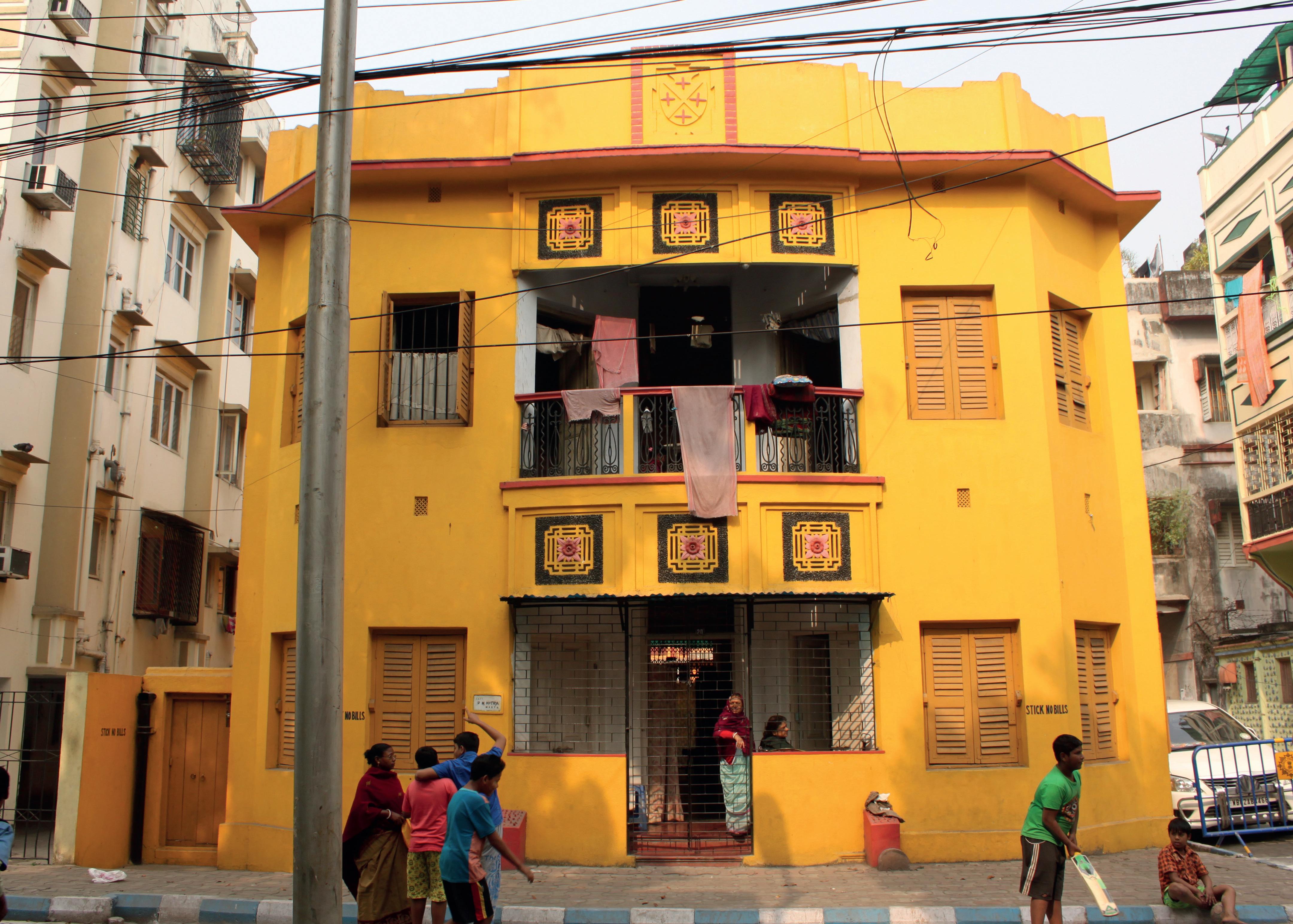ESALA 2019
Master of Architecture
PARASITUATION
[ CALCUTTA / KOLKATA







This catalogue is part of a collection published by the Edinburgh School of Architecture and Landscape Architecture (ESALA), Edinburgh College of Art, University of Edinburgh. It documents student design work produced in the Master of Architecture (MArch) programme in 2018-19. Each catalogue describes one of the following fve design studios in the MArch programme. The full collection is available to view online at issuu.com/eca.march.
Catalogues 2018-19:
City Fragments: Palermo Institutions. island territories vi: MANHATTAN scapeland eSTRANGEMENT / disPLACEment.
Parasituation [Calcutta/Kolkata].
The Other Paris.
The Streamlines, Vortices, and Plumes of the Blue Lagoon/Bath.
First published in 2019, eBook published in 2024. Published by The University of Edinburgh, under the Creative Commons Attribution Non-Commercial Non-Derivative 4.0 International License (CC BY-NC-ND 4.0). .
Wiszniewski, Dorian. Parasituation[Calcutta/Kolkata].
Edinburgh: University of Edinburgh, 2019.
Text © Author, 2019. Images © Author and Contributors, 2019.
Parasituation [Calcutta/Kolkata].
ISBN (eBook): 978-1-83645-097-9
Dorian Wiszniewski
This catalogue is a collection of architectural and urban design speculations undertaken in the Master of Architecture studio studying the city of Calcutta 20172019. This studio ran after a first Calcutta studio in the MSc Architectural and Urban Design Programme (2016-17) and alongside two further MSc AUD Programmes (2017-2018 and 2018-2019). The work of the MArch studio both influenced and was influenced by the outputs and processes of the associated MSc AUD Programmes. This catalogue sits alongside the first MArch Catalogue printed in 2018 and the book Argufying Calcutta: Parasituation [Kolkata], (Wedge Publications, 2019). All studios benefitted by the contributions of various teaching colleagues (Kevin Adams 1, Chris French 2, Maria Mitsoula 3, Neil Cunning 4 and Paul Pattinson 5 ), a range of guests from different disciplines, institutions and countries and all the international students across all programmes (noted at the back of each catalogue/book).
1 MSc AUD 2016-17 and 2017-18; MArch 2017-2019
2 MSc AUD 2016-17 and 2017-18; MArch 2017-2018
3 MSc AUD 2016-17 and 2017-18; MArch 2017-2018
4 MSc AUD 2017-18 and 2018-2019; MArch 2017-2018
5 MSc AUD 2018-19 and visiting critic to MSc AUD 2016-17, 2017-2018 and MArch 2017-2019.
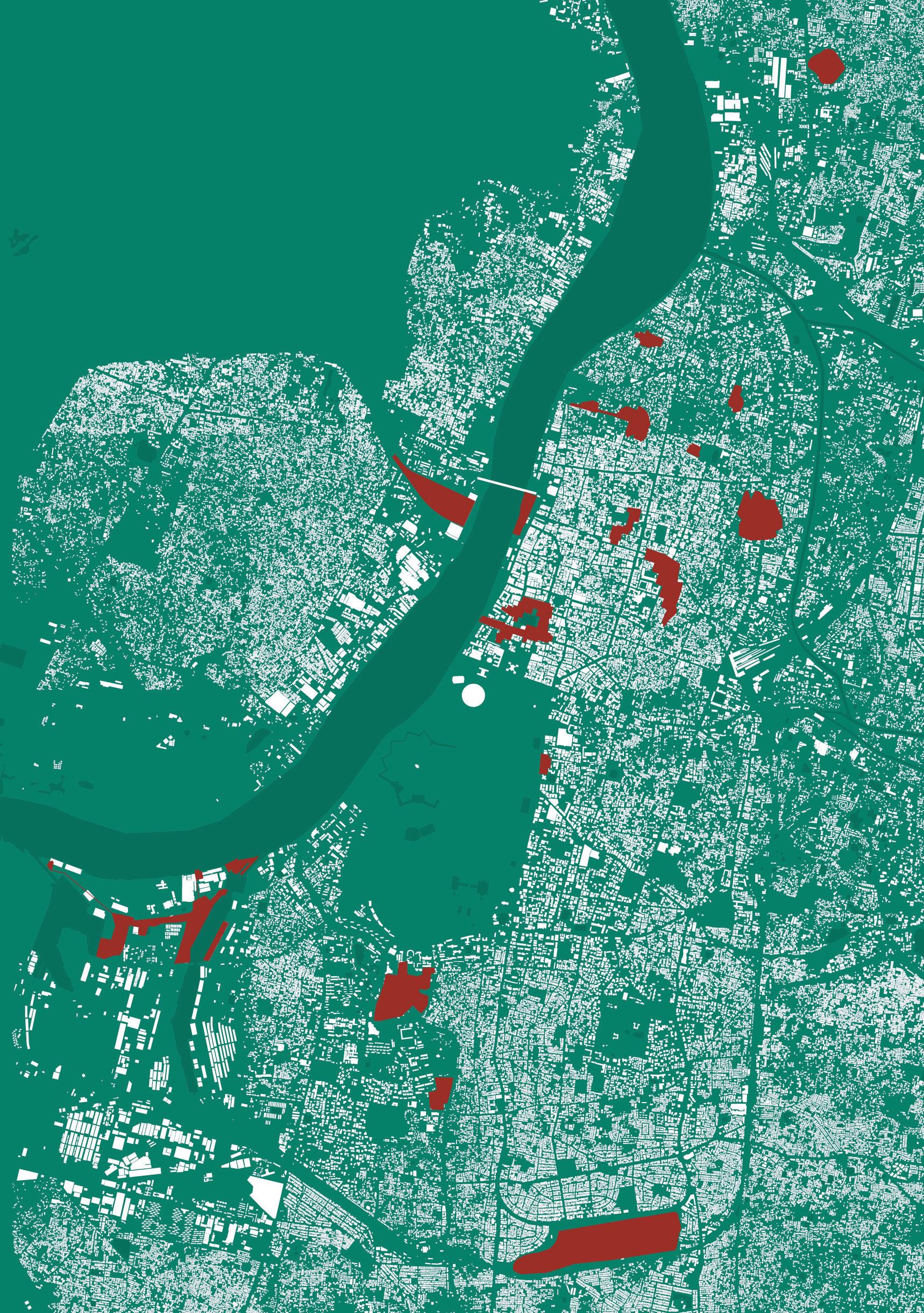


ere is a phenomenon in Calcutta called adda. It refers to informal conversations between people, “that can go on for hours at a stretch – at street corners, cafes, markets and living rooms.”1 is extended everyday discourse is either cause or symptom of Amartya Sen’s e Argumentative Indian; he says, “Prolixity is not alien to us in India. We are able to talk at some length … We do like to speak.”2 Importantly, Sen sees this tendency towards loquacity as the basis of “democracy as public reasoning.”3 is is the same “heterodox” communicative principle by which we encourage the operations of and between each of our studios, sta , visitors, students and speculations. However, alongside talking and necessarily more proli cally we encourage drawing and making – this is research-by-design, an authoring amidst authoring, design as productive “argufying” 4 – we are talking about design as much as we are drawing on Calcutta, intermingled procedures contributing to a developing thesis (argument) concerning how to be involved with Calcutta, how to speculatively envision a new possibility for Calcutta and how, then, such a speculation might become something like Calcutta and Calcutta something like the speculation.
1 Storyline text from the IMDb website for the film Adda,Calcutta,Kolkata(2011), directed by Surjo Deb, and written by Shayani Bhattacharya and Ranjan Palit, https://www.imdb.com/title/ tt2381081/?ref_=ttpl_pl_tt, Accessed 12/03/2019.
2 Amartya Sen, TheArgumentativeIndian,WritingsonIndianCulture,HistoryandIdentity (London: Penguin Books, 2006), p.3.
3 Ibid. pp.12-16.
4 See Amit Chaudhuri, On Amartya Sen and the Deferral of Indian Modernity, in Dorian Wiszniewski. ArgufyingCalcutta:Parasituation[Kolkata] (Edinburgh: Wedge Publications, 2019) pp.48-58
From the outset of our studio operations we installed our own version of a rawk (steps on the side of buildings, frequently at the thresholds to houses, designed speci cally to accommodate and promote adda) (see Figures 1 and 2). e 2019 book and the 2018 and 2019 catalogues record much of the adda about everything we could reasonably deal with in the time frame of our operations. e sub-themes are many but are guided by the two main themes, elaborated in the 2018 catalogue and 2019 book as Inside Out and Oceans Of Wetness.
A way we think the themes of Inside Out and Oceans Of Wetness is through scale. Our research methodology oscillates between body, building, series of buildings, neighbourhood, metropolitan landscape, region, nation, and global scales. ese are well-recognised political scales. However, they also speak of environmental scales. Our programme is determinedly interested in the environmental to political scale relationships. Architecture, we argue, mediates these scales. We like to think of architecture as mediating between oscillating cosmological and cosmopolitical scales. Our bodies are borne of the cosmos and are compelled to navigate every cosmopolitical scale. We like to think politics by equally thinking cosmos. is is what we mean by cosmopolitical – rather than de ning the cosmos only through politics (and draw absolute cartographic or architectural divisions through mountain ranges, rivers and other environmental continuities, including peoples, and subject them to discontinuous political managements), we prefer to allow for political practices to be shaped by the cosmos. erefore, for our programme, what we call cosmopolitics is already considered cosmological. is dynamic is key to understanding the impact of Oceans Of Wetness. Oceans Of Wetness, cosmologically considered, is product of our sun acting upon our oceans. However, as a cosmological phenomenon it saturates every cosmopolitical scale: wetness is the e ect of every cosmological moment in our everyday cosmopolitical existence. Inside Out is how we tackle each scale. Inside Out is how we tackle wetness. We think of each scale in turn, gradually outreaching, stepping from one scale to the other, oscillating between large and small – our bodies always in contact with the cosmos and the things we make as cosmopolitical artefacts. Every scale of our argufying, then, is immersive, literally and metaphorically, cosmic and political.
Between the three di erent publications, between texts and images, a reader will come to terms with something of Calcutta. Calcutta is a wetland. It sits on the eastern side of the river Hooghly, opposite the separate city of Howrah. Calcutta sits where the landscape of the Indian sub-continent and the fertile plains of Bengal meet the lush wetlands and jungle of the Sunderbans, a situation

where water and land operate as precise equivalents. e Hooghly is less a river than one of many great concentrations of wetness that run through the alluvial landscape from the Himalayas to the North to the Bay of Bengal in the South. e absoluteness of political boundaries in such a uid fertile landscape seem absurd. To have the dryness of a nite political cultural line in such a situation takes great cosmopolitical conceit never mind e ort, perhaps an e ort which, ultimately, we determine a cosmological impetus can and will redistribute.
e themes of Inside Out and Oceans Of Wetness are elaborated in the 2018 catalogue and 2019 book. As noted there, Inside Out pays respect to the late Diane Lewis. Her thinking and book of the same name is highly in uential. It promotes architecture, drawing and building as highly skilled cultural mediation, as signi cant as the written word. We agree with Diane and also promote architecture as holding this communicability. Much has been written on the problems of the temperate imposition of the Global North in the Global South. Something of the cosmopolitical stress of such tendencies is well narrated, for example, in George Orwell’s Burmese Days. e cosmological impetus of our work is greatly in uenced by our friends and colleagues Dilip da Cunha and Anuradha Mathur who rst proposed Oceans Of Wetness as a manifesto.5 In his most recent book, e Invention of Rivers: Alexander’s Eye and Ganga’s Descent, Dilip richly records the temperately focussed perspective spanning from ancient times to the zenith of modern geographers. He counterposes this with an ancient Indian perspective which Anu and Dilip have further articulated as a chapter, A Clash of First Natures, in our book, Argufying Calcutta: Parasituation [Kolkata]. We are extremely grateful to them. Our work, therefore, tries not to build from a temperate bias. Rather, it explores Oceans Of Wetness Inside Out; it explores Calcutta as birth place to cosmologies which, in turn, provide inventive language for how architecture might redistribute speci c cosmopolitical situations,
“deepen[ing] a wetness that is already everywhere in some degree, a wetness that does not ow as water does but rather holds in clouds, air, earth, and living matter. It [the architecture of wetness] soaks, blows, seeps, osmotes, and transpires its way to ever-extending holdings of wetness, holdings that eventually become the ocean that reconnects with the wind.”6
5 https://www.mathurdacunha.com/ocean-of-wetness
6 Anarudha Mathur and Dilip da Cunha, A Clash of first Natures, in Wiszniewski, Argufying Calcutta:p.152.
Our work is neither inside nor outside the colonial and post-colonial narratives of Calcutta. Rather than being caught in this pre-politicised bind, we take our leave from a deeply considered architectural/cultural impetus. Our research works towards what we consider to be Indian Modernity: we are looking for it and work Inside Out of what we nd, even if it is only a seductive glimmer of an interpretive possibility. What we consider modernity must be distinguished from the merely modern and the frequently prejudiced memory of Modernism. Modernity, as the OED tells us, is “an intellectual tendency or social perspective characterized by departure from or repudiation of traditional ideas, doctrines, and cultural values in favour of contemporary or radical values and beliefs.” is is not quite right for us either. It is partly right. In fact, it may be possible that Indian Modernity gives us a di erent de nition altogether. We are in favour of the contemporary over either glori cation or repudiation of a past. We see history as a continuity, neither in progress nor decline. We pursue a critical optimism of what it is like to be in India, in Calcutta, living for the moment, looking to futurity but not ignorant of the past. Modernity, thus, is evident in many periods. We are interested in heritage in so far as we care about who inherits what from whom and that it is invested wisely – ecosophically, cosmopolitically. erefore, the most important moment of modernity for us is the relevance of the futurity of a then as it intersects with a newly relevant now, and for us as architects, in a predictive adequation of futurity. Our speculations are invested in this optimism and look to build from a wisdom we nd both cosmo-logically and cosmo-politically in Calcutta.
We have begun our search for Indian Modernity by drawing up “measured intensities” – intense situations intensely measured. We took our initial cues by looking at the works and some addresses important to prominent Bengali Bhadraloks – for example, Ashapurna Devi, Indira Devi Choudhurani, Kaliprasanna Singha (Hutum Pyencha), Jaladar Sen, Troilokyanath Mukhopadhyay, Narayan Gangopadhyay, Punyalata Chakrabarti, Kazi Nazrul Islam, Shailajaranjan Mukhopadhyay, Premendra Mitra, Brahmabandhab Upadhyay, Charankavi Mukundada, Rajshekhar Basu (Parashuram), Ramendra Sundar Trivedi, Sukumar Ray, Satyacharan Laha, Birmalacharan Laha, Gauharjaan, Brajendranath Sil, Hitabadi Patrika, Krishnakamal Bhattacharyya, Haraprashad Sastri, Prashanta Chandra Mahalanabish, Michael Madhusudan Dutta, Satyajit Ray, Sachin Dev Burman, Pandit Gyan Prakash Ghosh and Henry Louis Vivian Derozio. 7 We also looked to the house of Sukanya Mitra, a contemporary Bengali scholar and
7 This list was provided by Sanchitta Bhattacharya and Anirban Mondal (via Amit Chaudhuri), heritage researchers in Calcutta, September 2017.
Calcuttan bhadrolok, and the street where Amit Chaudhuri’s uncle lived, the subject of his book A Strange and Sublime Address. We looked at some Bhadralok situations more intensely than others, but always mindful of each as speci c exemplar of this special collective who provide the inheritance of subsequent generations of culturally driven Calcuttans.
For our “measured intensities” we took some impetus from Patrick Geddes. Knowing his exchanges with Rabindranath Tagore we see within and between them further sources of a sensibility towards Indian Modernity. Rather than looking speci cally at Tagore’s poetry, we are inspired more by the modernity of his humanism, perhaps most evidenced in his open educational thinking at Shantiniketan (a key subject of the Tagore/Geddes letters).8 We look to Geddes for his speci c input into the Barra Bazaar, a most amazing dense layering of hybrid civic programmes covering about 1km by 1km square where the entire ground oor and streets are given over to market, most of the rst and next two to three oors operating as residential accommodation, and with a roof-scape partially activated as extension of the common social spaces of the inner courtyards.9 is area is frequently considered as a bad example of urbanism. However, as Geddes, we see merits.10 Our “measured
8 See Bashabi Fraser, AMeetingofTwoMinds:GeddesTagoreLetters (Edinburgh: Word Power Bookshop, 2005).
9 For specific measured intensities of Barra Bazaar see Wiszniewski, ArgufyingCalcutta, pp.87-202.
10 See Patrick Geddes, BarraBazarImprovement,AReporttoTheCorporationofCalcutta, (Calcutta: The Corporation Press, 1919).
intensities”, therefore, can be considered something of a Geddesian “diagnostic survey.” However, rather than looking for illnesses that require some “conservative surgery” to make the situation well again, we look for what we consider to be signs of urban health. We develop what we call a “Prognostic Survey.” We consider situations that seem providential and test how they might act enzymatically to propagate reciprocally propitious relationships across and between all cosmological and cosmopolitical scales. We begin Inside Out from a survey but by developing it alongside a cosmological projection of Oceans Of Wetness we create a speculation. Rather than acting from a curative principle we nd and speculate from the basis of what we consider to be fecundating. It is the fecundating rather than curative principle that charges our “argufying”. We present this work and the two parallel publications as records of much of the adda about everything we found to be cosmologically and cosmopolitically fecund in Calcutta.


KEVIN ADAMS
“aesthetic rupture works to qualify a body whose dwelling is geared neither to its task nor its determination” 1
As a city originally moulded in the image of a British Colony by the East India Company, Kolkata is an uncanny experience. It is an architectural fool’s errand, a Georgian set piece trying desperately to hold on to its decorum whilst knee deep in mud. Cities are places of continual evolution, even cities that have experienced the trauma of con ict usually regain the momentum of development with the centres often becoming commodi ed; grand old buildings are conserved and fetishised and the institutions are revered. e years of post-independence Marxist rule have ended in Kolkata and the relentless rituals of what constitutes street life in the Asian subcontinent determine a temporality that resides in the moment. Here many of these rituals take place within the shells of its former colonial institutions and this is what provides the uncanny, the feeling of a stage set. When you walk through the old districts of Kolkata, you experience an architecture of dilapidation not caused by economic woe or ignorance but rather, you suspect an active will of disengagement. Here you experience a rupture in the urban evolution of Kolkata, caused by a series of related acts that are still playing out on its formerly grand stage. It portrays the sense of being one thing whilst behaving like another but its reality is more complicated even than this. Cities generally have more than one character and this is an important aspect of why Calcutta (to use its historical title), as a place strongly conceived under the in uence of a singular body, is ultimately revealed to be a folly.
1 Jacques Rancière, Dissensus On Politics and Aesthetics, (London: Bloomsbury, 2015), p.148.
To understand modern Kolkata better it helps to mention some of the aspects that play a role in determining its being. Its situation is indisputable and it is what provides the city’s raison d’être. Kolkata is a place apart, a part of India, a part of West Bengal. It is an administrative capital, a metropolis, former seat of the British Raj and home to over ve million people. It occupies the east bank of the Hooghly River, one of two distributaries formed when the Ganges splits 260 km further upstream. Traditionally known as Ganga, the Hooghly is considered as sacred water within the Hindu community and Kolkata sits on an alluvial clearing of the Gangetic Plain at the head of the river’s tidal limit and on the northern edge of the Sundarban wetlands. e Sundarban is a vast mangrove swamp, shared with Bangladesh and forming the Ganges delta between Bengal and the Indian Ocean. It is a massive convergence of fresh Himalayan water swept downstream and salty tidal brine heading inland. e alluvial clearing was originally home to a collection of villages under the rule of the Mughal empire but the location was chosen by the East India Company, at the end of the seventeenth century, as an ideal base for its continued expansion into the hinterlands. It is a place of physical, cultural and spiritual encounter, a place of reckoning situated between the world’s highest mountains and largest delta and it is one of the lowest lying and attest places on earth. Kolkata is clay mud, it sits in it and is made of it. e once pristine white architecture is actually made of cheap local bricks, rendered rstly in lime and more lately with incompatible cement techniques. e rampant fecundity of its tropical climate is all consuming and it lays siege to any buildings left unprepared.
Kolkata serves a vast metropolitan region and it does this through a lively mix of industry and commerce. A lot of this trade takes place within the tight con nes of the Barabazaar, an old and established part of central Kolkata that sits between the White and Black Town districts and anks the Hooghly. It resides within solid and densely packed eighteenth and nineteenth century architecture that hosts an overwhelming deluge of commercial activity. e buildings appear to be poorly maintained and electrical services run between and across them like spaghetti; but they were never intended to be places of appearance - these are places of production. e architecture might be ruinous but it’s also accommodating and the occupants seem constantly to adapt it to their requirements. ere have been attempts in the past to make civic order from within this maelstrom of human industry; for example, Patrick Geddes wrote a report that was partly enacted by the city corporation following its production in 1919, but little impact can be observed and the actions of making and selling drive this area relentlessly. As with other areas of craft and labour in Kolkata, it’s hard to ignore the very close proximity of living with working. Districts such as Kumortuli, where the world-famous clay
idols are hand made, are home to artisans, itinerant labourers and their immediate families, often all within closely con ned spaces.
ere is also another way of life in the city that does make space for living and working in quite a di erent way. In the suburbs of both the old Black Town area of north Kolkata and White Town to the south of the city there exists residential districts that were built by moderately wealthy Bengalis, generational o -spring of the Babus. e original Babus were an independent merchant class who prospered from the burgeoning trade of the developing metropolis during the colonial era and their children became richly educated in the arts and humanities; this was unwittingly facilitated by the British laws against access to the study of science and engineering for those of Indian nationality. e legacy of these subsequent generations, known as Bhadraloks, meaning gentlefolk, is a unique reenactment of Bengali culture that is separate and distinct from mainstream Hindi nationalism and deliberately positioned to distance itself from its previous colonial subjugation. is is an intellectual existence, para-urban in nature, often secular, distinctly modern in its outlook, taking place within distinct neighbourhoods and streets and elegant shaded living rooms shuttered against the sharp sunlight. ese are now mostly decaying properties that house generations of collected heirlooms and the personal trappings of a cultured, bourgeois life.
Modern Kolkata appears then to be in a state of active and spirited rupture. Colonialism left the physical trappings of institutions, now co-opted by the current political incumbents to endorse a representation of consensual political authority. However, this is neither the task nor determination of the city. e city’s occupants are busy adapting, making and theorising their existence irrespective of appearances and within the context of a demanding climate and unrelenting alluvial conditions. Its recent post-independence history has, seemingly unwittingly, provided a platform for self-reliance and coexistence of many seemingly disparate activities, cultural and industrial, old and new. is is why we nd Kolkata such a place of abundance and so rich a situation for speculations, which, in turn, determine the tasks necessary to new architectural and urban envisioning.

|
January 2018 | Kate Le

e aim of this thesis is to create Vessels of Culture which encourage and promote further intimate water bonds within the apparent everyday anarchy of intense urbanization connecting the vibrant city with the water-bed of the Hooghly River. Centuries of human presence in the area have formed a rich cultural fundament upon which contemporary inhabitants have settled. Opening the city towards the Hooghly through a series of striped buildings with uses such as Library, Elderly Community Center, Nursery, eatre and public walkways, will recreate the intensive bonds between the city and the river.
A ghat is the openness of a community towards a neighbouring river bed through a stepped formation. Indian culture retains deep spiritual connection with its rivers. e aggressive development of the city towards the river has isolated the city from its water source. e ghats of the Calcutta’s Old Town nowadays form some of the most famous Markets in the city. Howrah Station feeds the markets and the city with products, people and culture from beyond. e Hooghly Bridge empowers the natural ow from the west to the east side of the city, while human intensity within and around the bazaar areas has shaped a pattern between time and space.
New striped patterns set the rhythm of a new Cultural Center as an architecture that respects the ghat. Working as complimentary gures set above and within the ghats, they enhance community amenity and access to and from the river.





In Towards and Ecology of Mind, 1 Gregory Bateson de nes that a healthy ecology of the city is a single, complex dynamic system of environment combined with a highly developed human civilization. e system would have fundamental and basic features which are open to slow and gradual changes reciprocally between civilization and the environment; a new kind of urban exibility would emerge where urban patterns would match environmental patterns.
Constructed by the British East India Company, Kidderpore Dock is one of the oldest operating ports in India. Once it was the busiest trading centre in South Asia and Calcutta; now the dock is marked by largely redundant industrial cargo warehouses and dock machineries. Yet, on the dock’s east side, the residential areas remains densely urbanised. e architectural and communal boundaries between the dock territory and residential territory are clearly de ned by archaic industrial infrastructural patterns.
is project breaks the hard urban boundary within Calcutta. e pattern of the Calcutta wetlands is superimposed over the existing patterns of Kidderpore Dock, as if one system is imprinted into the other. is promotes a new healthy urban ecology with high degrees of programmatic, material, formal, technological and environmental exibility. By such a re- and de-territorialisation of the Kidderpore dock, Kidderpore Dock slowly transforms into a dynamic and reciprocally exible human-environmental civilisation.
1 Gregory Bateson, “Ecology and Flexibility in Urban Civilization”, in StepstoanEcologyof Mind, (Chicago: University of Chicago Press, 2000).

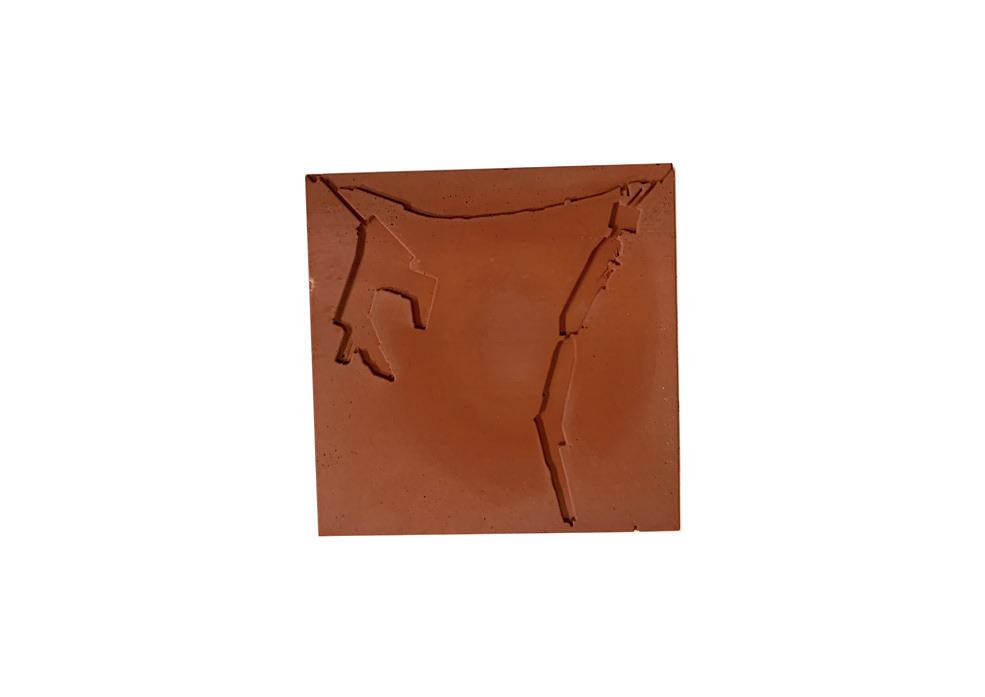
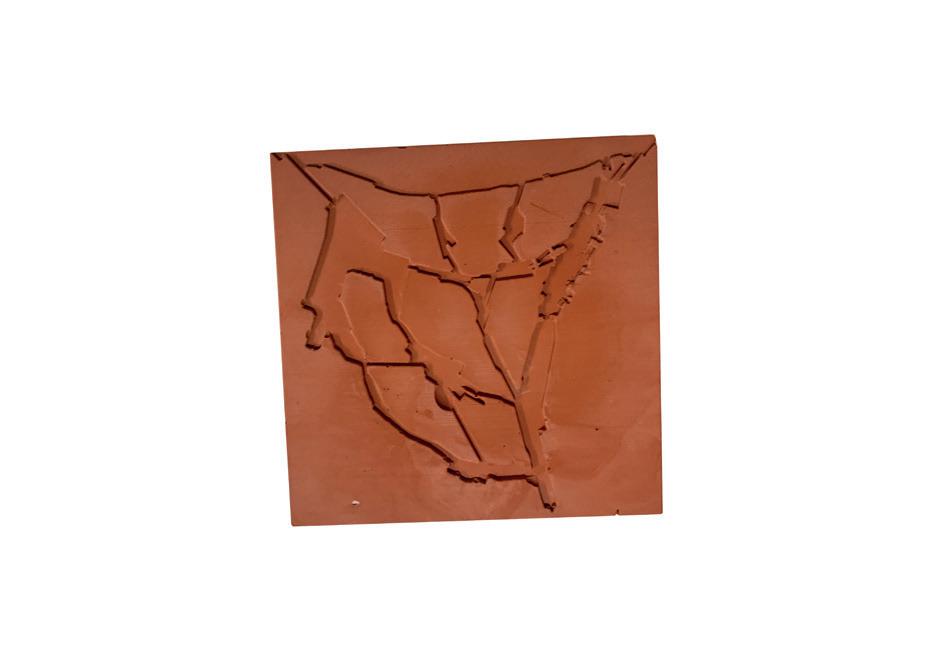




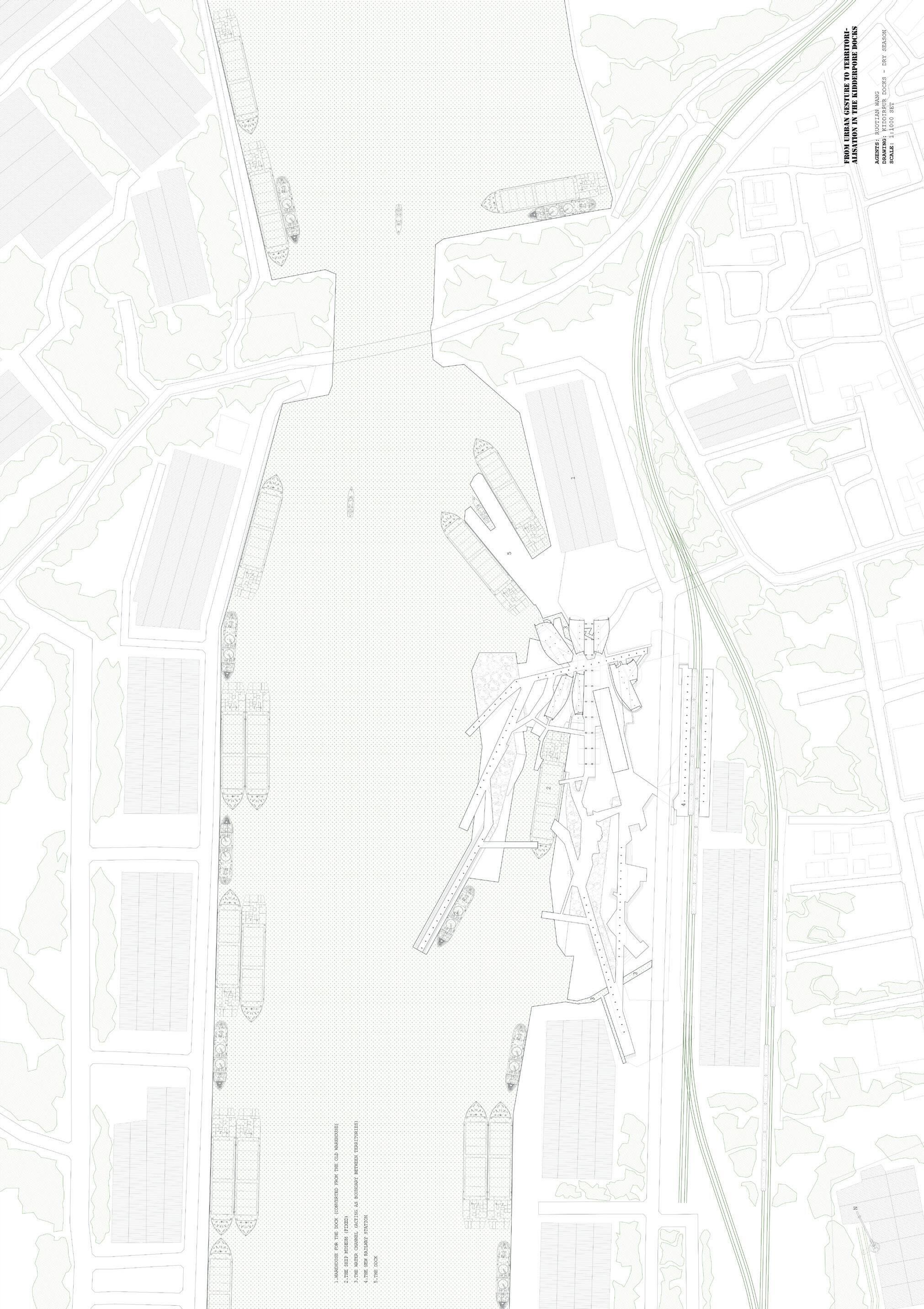
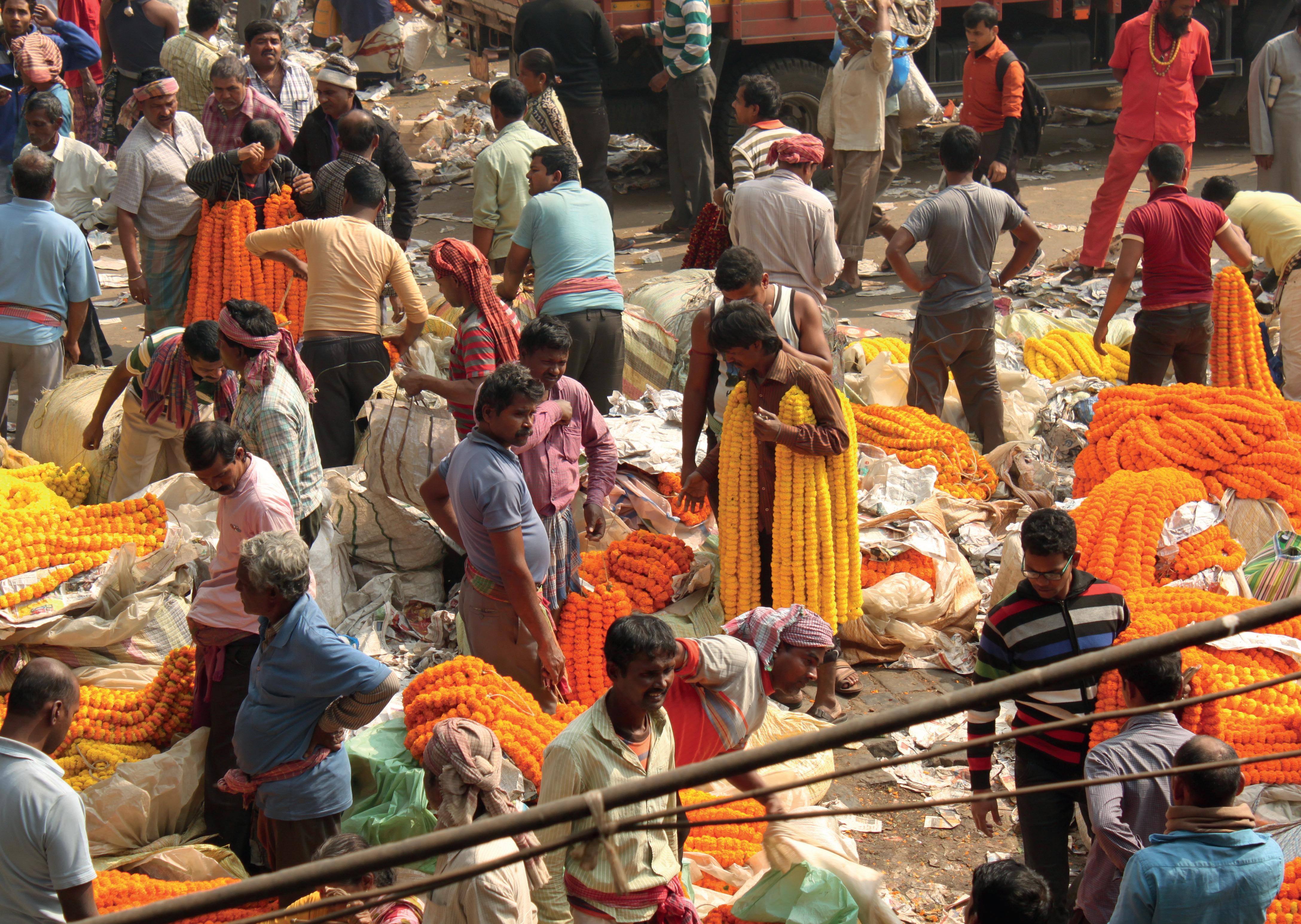

is project o ers an agricultural re-appropriation and re-calibration of the landscape at the Kidderpore Docks where the architectural proposals embody the process of saturating, immersing, folding and impressing the existing and speculative new data of the Kidderpore landscape, and thus, augmenting the landscape further.
e Kidderpore Docks is a seminal territory of South Kolkata that provided the initial entry into the city, economically, politically and geographically. Situated in the Southern end of the Hooghly river the docks had been infrastructurally developed during the British Raj to become focal point of the shipping and travelling industry. Over time, the governmental authorities of the Kolkata Port had de ned a boundary between the private and the public, thus highlighting a hard, impermeable border.
What the eld trip and intense survey of several locations in the city had revealed was the character of residential spaces being closely knit with spaces of production and trade. e Kidderpore Docks are explored and recalibrated through the lineaments of Kidderpore market and 529 Rabindra Sarani printing house – places of particular social and urban character that immerse productivity into everyday life.
Geologically, Kolkata is situated on a rich bedrock of clay and silt, almost sinking the city into the water-rich, porous soil. us, the project aims to bring out the gesture of the pre-existent land and reveal that through techniques of unfolding, imprinting and saturating in drawing and modelling form, allowing the architecture to emerge from this process. e architectural programme oscillates between processes of re-using the existing silt, extracting the water for growing crops in the new landscape and harvesting and distributing the resulting production.


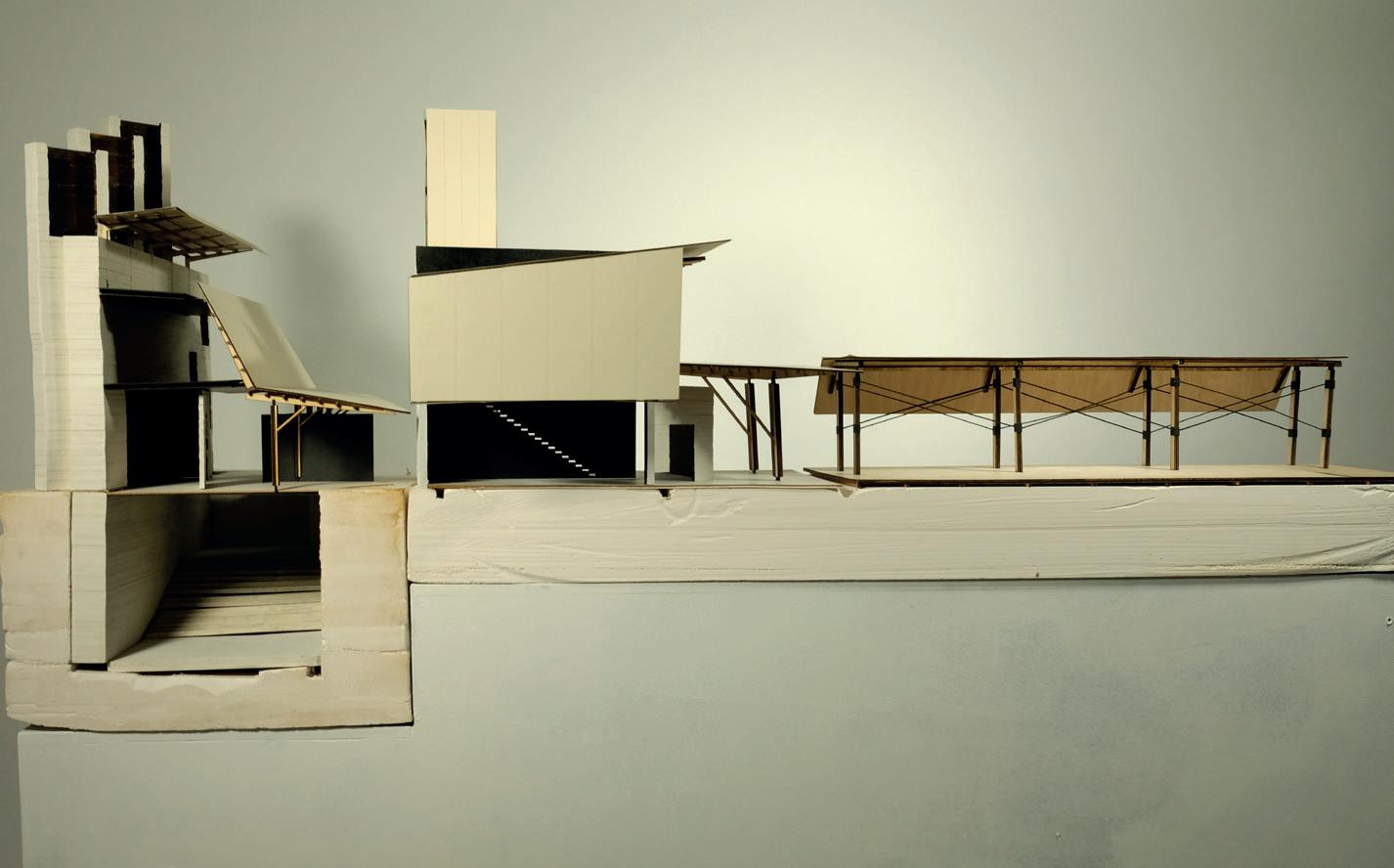
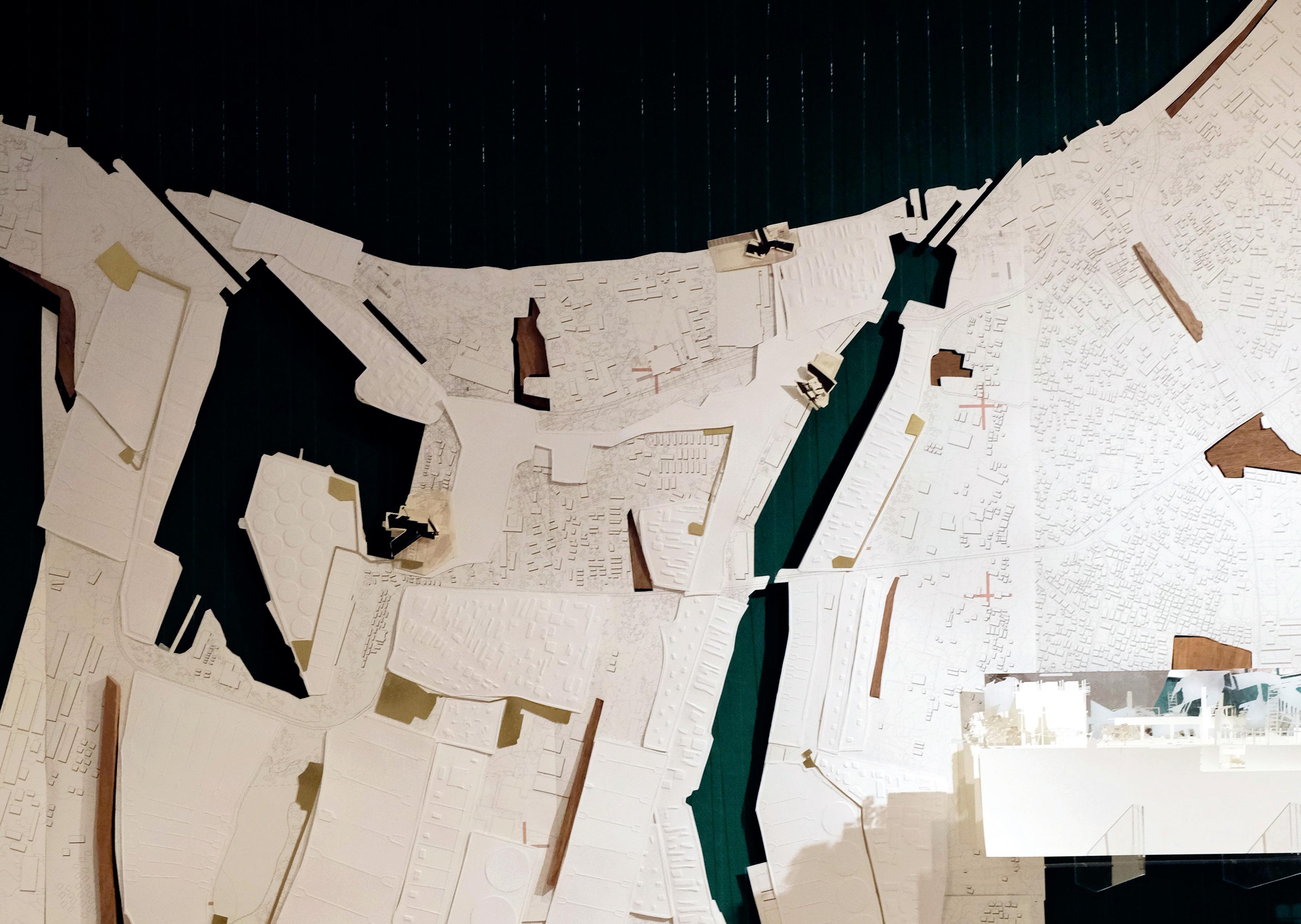

BELAY HAGOS
Aedicule, from the Latin Aedicula, “denoting a small shrine containing Roman household gods or, in a temple, the statue of a god; the structure covering the Holy Sepulchre. Also: a representation of a structural feature (usually in miniature) for ornamental purposes”.1
Satadru Pain, a regular of the co ee house, sits in the privacy of his table and orders co ee. Sat across from a foreigner he begins to divulge dialogue t for politics & the arts. He nishes his drink. Iraz Malik, the owner of the book stall, sits in his usual sanctuary sipping chai. Sat across from a foreigner, he too begins to divulge dialogue t for politics & the arts. He nishes his drink.
e Enveloped Aedicule is an architecture that comprises spaces to sit and have co ee and chai with the company of a book borrowed from the library in the Aedicule or bought from the book stalls outside.
e Enveloped Aedicule is an architecture that recon gures and reinterprets the con nement of co ee and the seclusion of chai and designs a tactical gap, an architecture that slips over and between the two commodities.
e gap, the Lingual Library, a blur in the relationship between the two agencies, is stirred to provide spaces that negotiate the common ground between drinkers of co ee and tea and beyond into the academic ground of College Street.
In the Enveloped Aedicule the waiter dressed in white uniform wearing ip- ops strides to the table. He places the ceramic cup for co ee and the clay cup for chai on the table, as the two continue in their Adda.2 In the corner, Michael Madhusudan Dutta, the Bengali poet, the bhadralok, sits in the privacy of the English Language room, drinking tea, smelling the co ee, writing Bengali poems about politics.
e workshop in which Michael composes accommodates and blends multiple agencies.
1. OED
2. Wiszneiwski, “Much Adda About Everything” p.4, in this volume.
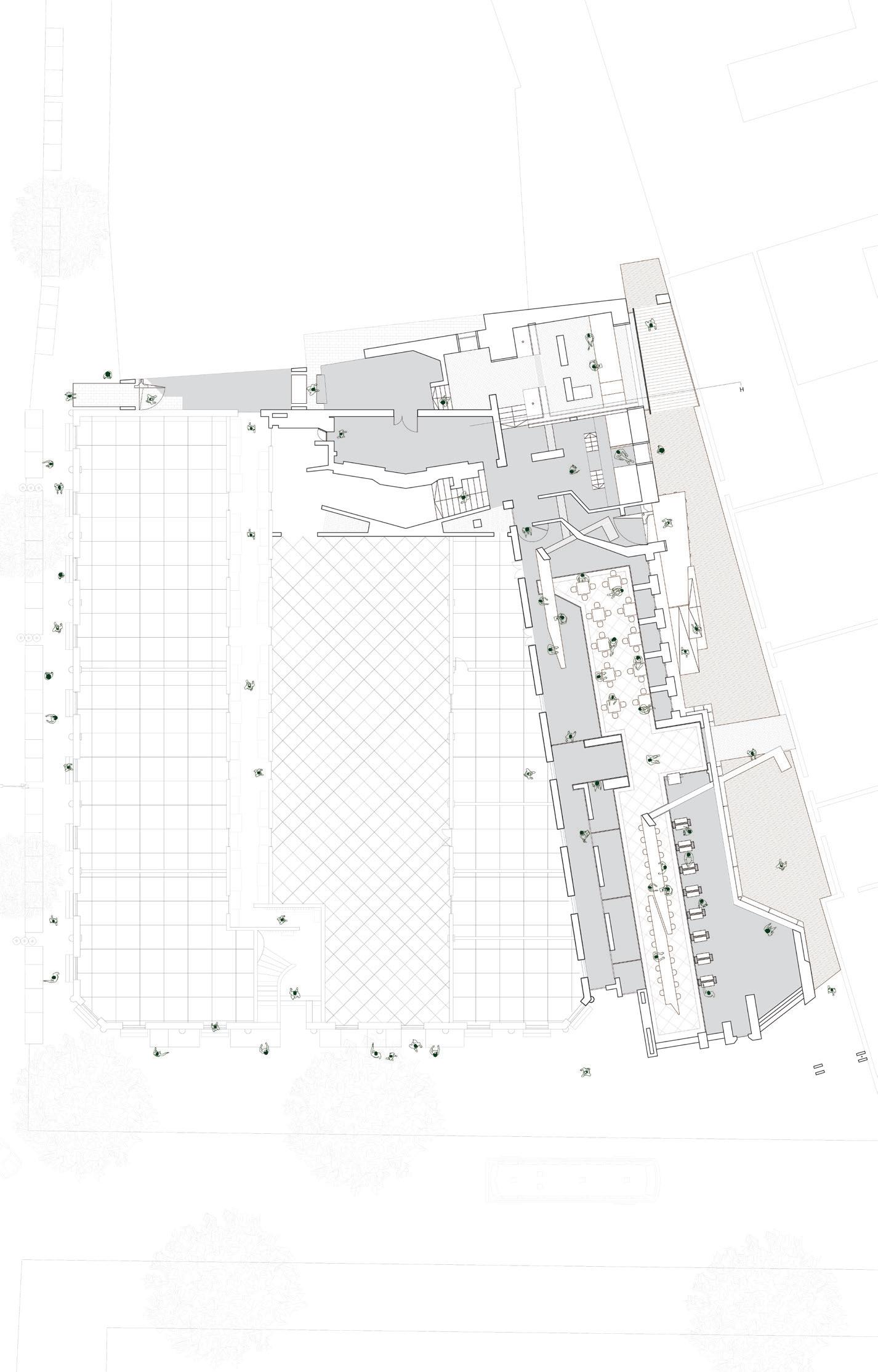
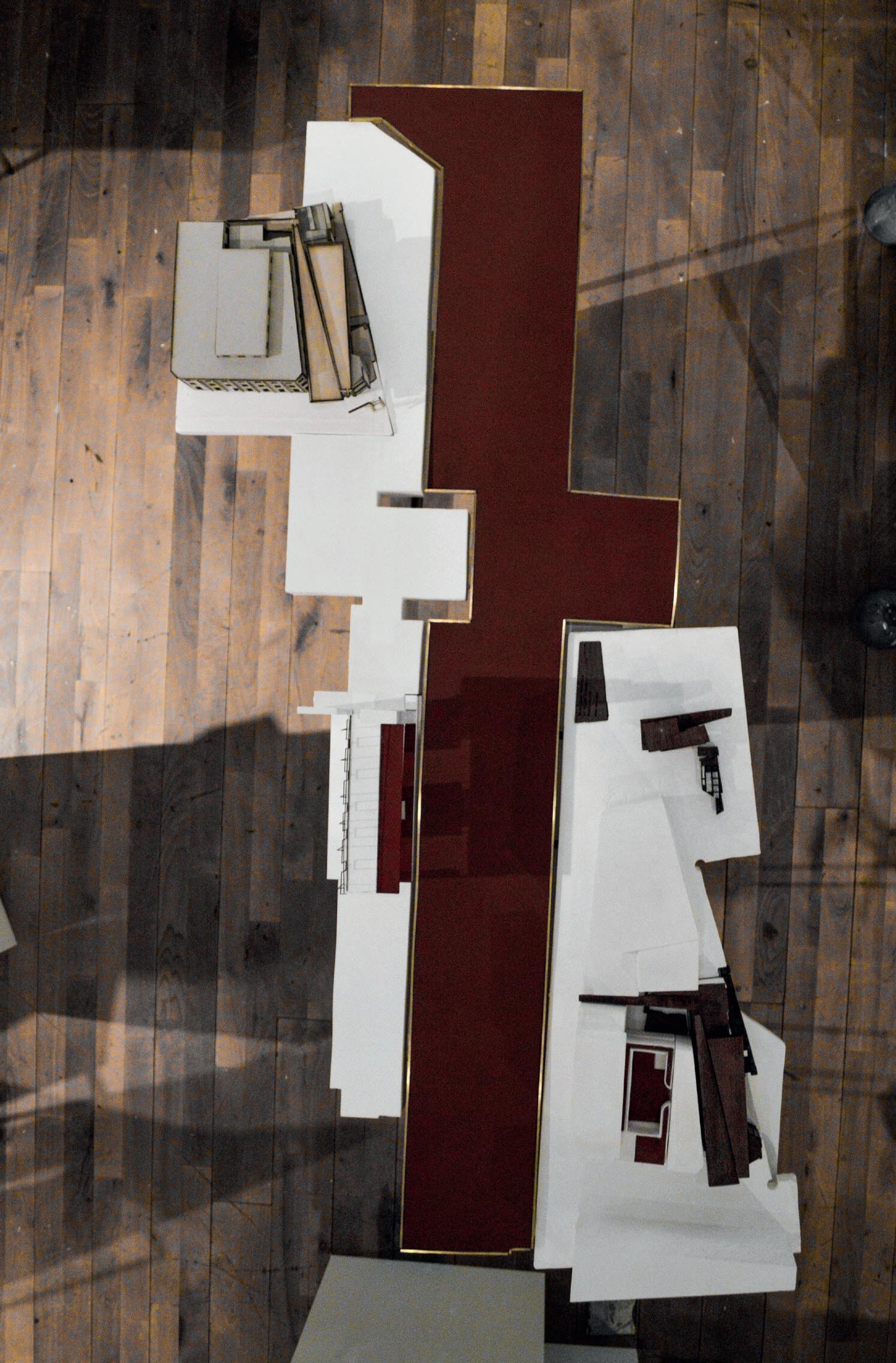

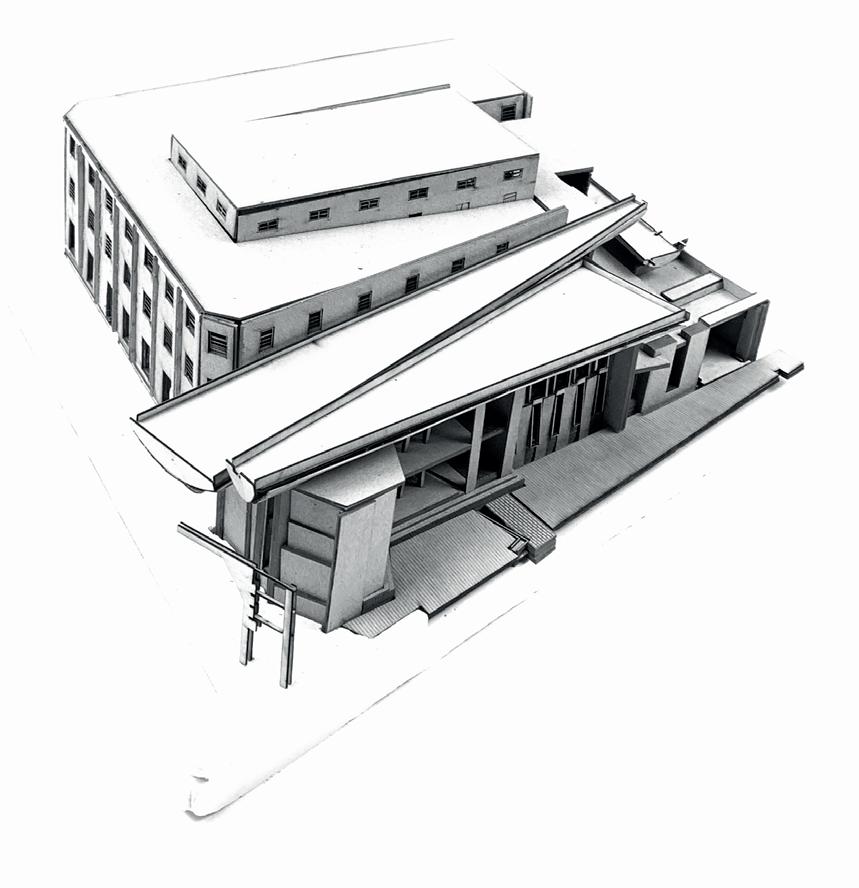
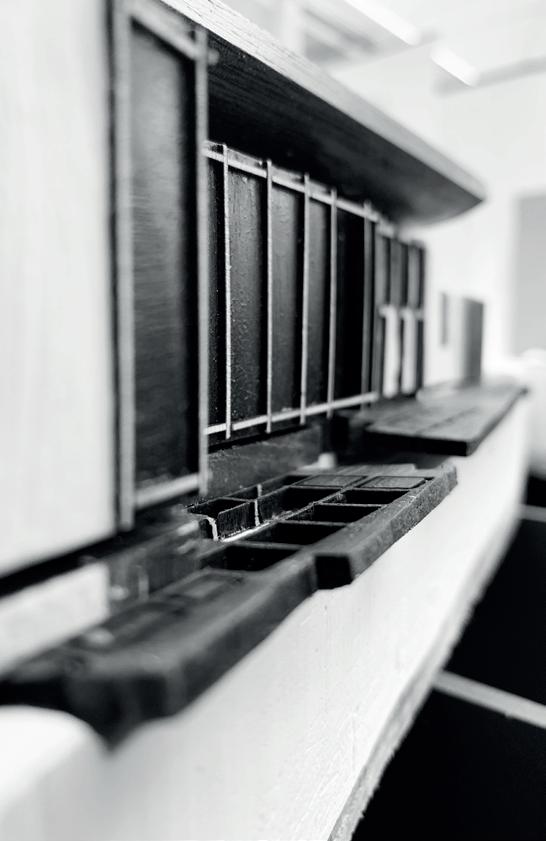
MANGO RHYTHM
e Writers’ Building and Howrah railway station are both examples of complex networks and assemblages that comprise numerous ‘actants’, be they human or not, that evidence the collecting, recording and distribution of many things of value and agency. Bengal Scents | Mango Rhythm investigates contingencies between di erent ‘actants’ through a speci c a ording agency – Indian Mangoes. e proposed West Bengal Mango Guild consists of a small-scale mango orchard, a debating chamber, various social spaces and beds.
Situating the building in between the old and new Howrah station, the West Bengal Mango Guild grafts the station together. Attaching an agricultural productive landscape to a civil engineered underground metro formulates a new equation - it speculates the propitiousness of what the East-West metro could bring to the city of Kolkata not only as a way to distribute people but also goods. e assemblage now acts as environmental remediation, creating a system of productive-landscape distribution as much as the products of landscape distribution.
e thesis blurs the boundary between inside and outside, land and water. Rather than repelling the water from the Hooghly river, it attracts and handles the water carefully to prevent the orchard from being too dry or too saturated, ensuring optimal water level for nurturing both fruit and population. Multiple positive drainage channels along the metro viaduct encourage water ow locally but also between Howrah and the East Kolkata Wetlands.

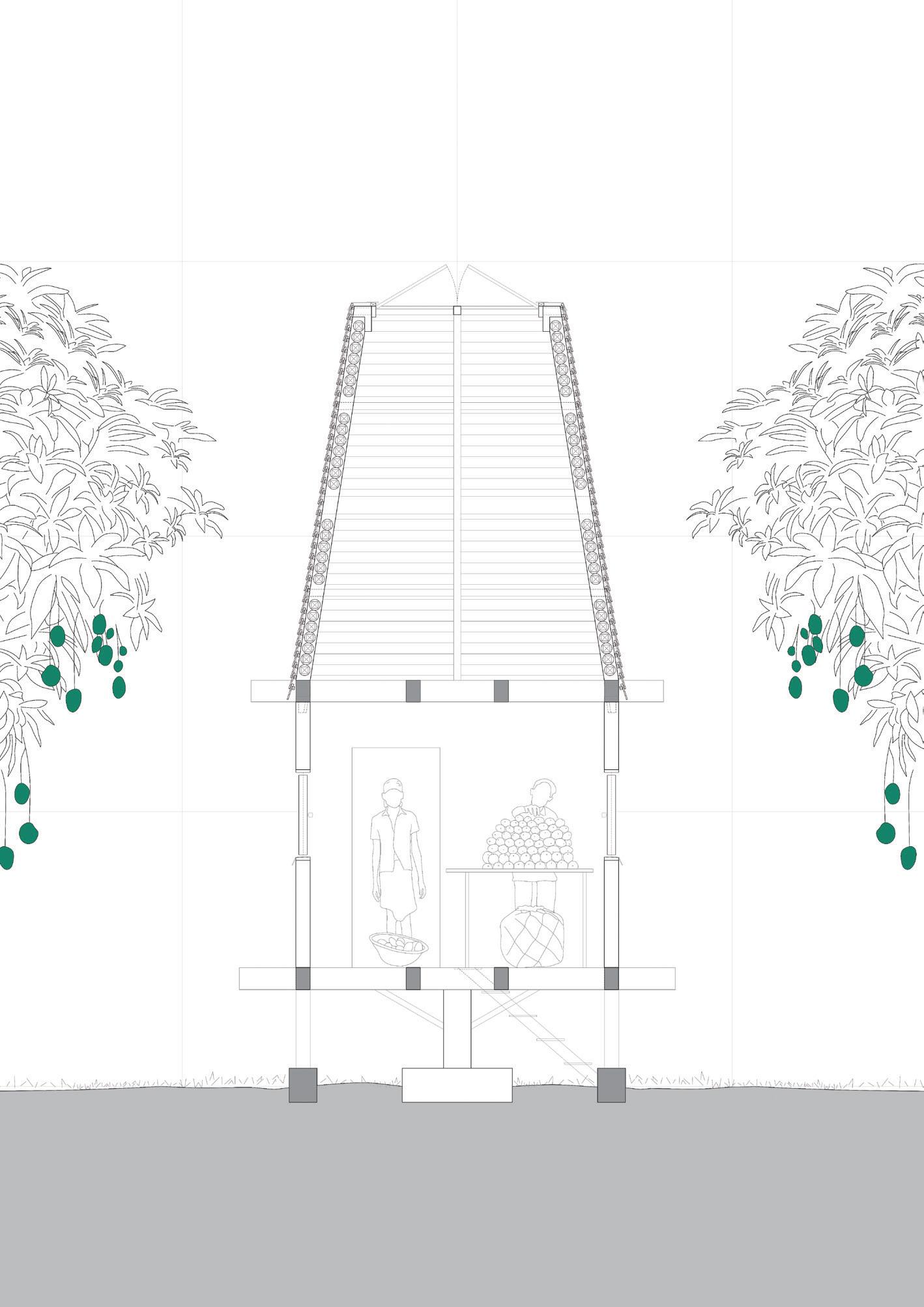

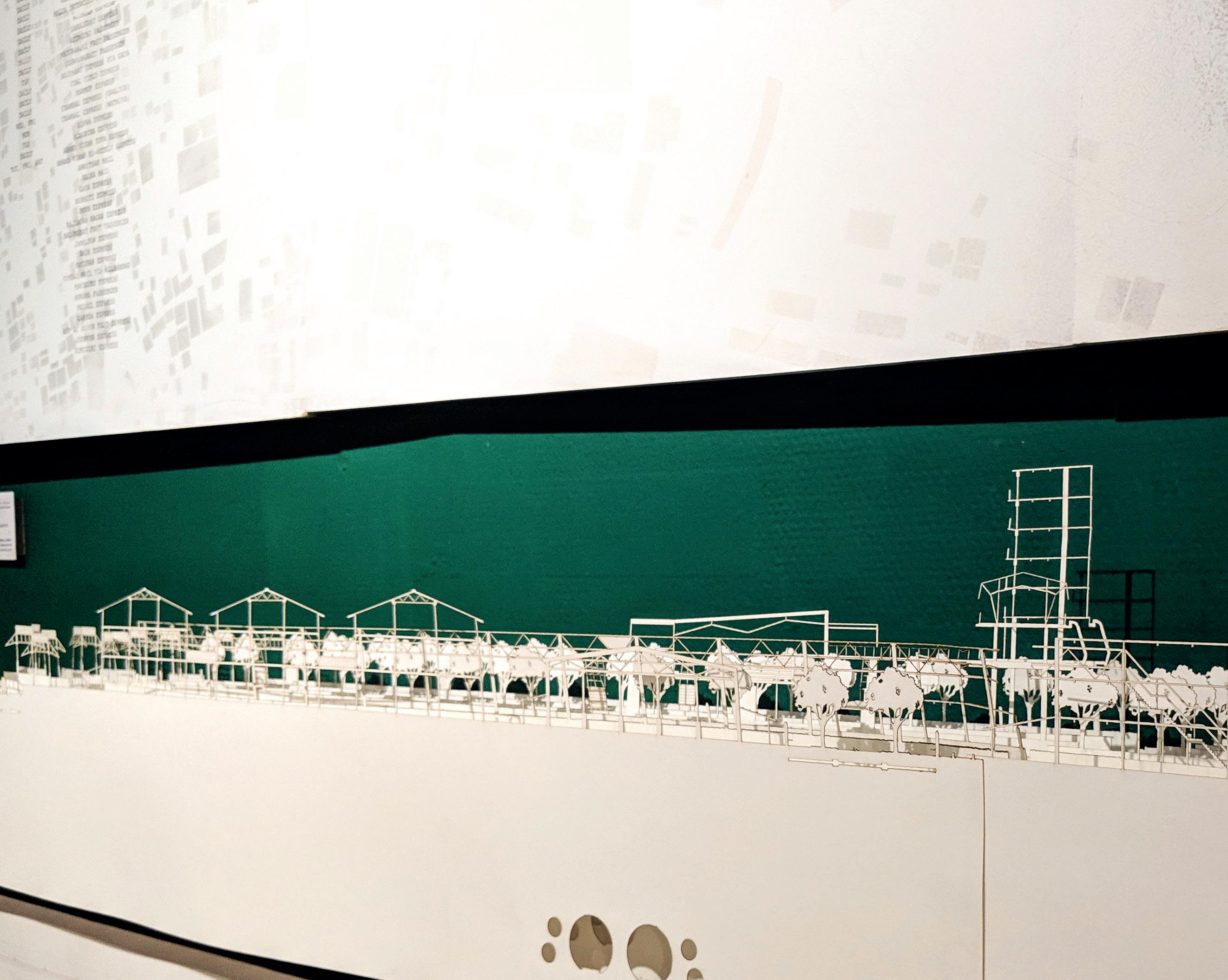
Blotting Ornithologics saturates conventional design methods to release the “white”, wet, public ground from the private, awed dryness of gured black. e project harnessess the avicultural wisdom found in Satyacharan Laha’s Pet Birds of Bengal, following the logics of the bird’s eye view to challenge human lines of territory between city and jungle, and bring back the fuller ecology of the wetlands to Kolkata.
e thetic drivers of Laha’s Agrapara aviary and Sukanya Mitra’s house carry their intelligence across scales to new sites, found and “blotted” between the overlapping layers of ornithological requirements and the existing gure-ground of Calcutta to form new “blotscapes” within “birdscapes” within an “Ocean of Wetness”.
ree of these territories of “whiteness” are at once created and sustained by strategically placed, newly conceived objects of “black”. e blotting instruments of the Oriental Skylark, the Blue Whistling rush and the Common Iora negotiate “enzymatic territories” using senses speci c to their species and draw in wetness from surrounding water systems. ese “ecosophic objects” form in ltration basins which slow water down and soak it away to alleviate runo , while creating public landscapes from which the environmental and structural cores of the architecture rise.
e three buildings form the Calcutta Institute of Aviculture; they share a tectonic language but develop species speci c programmatic and architectural mutations. eir open envelopes provide shade, rain cover and air movement, creating outside buildings which hold moments of environmental control, all drawn in di erent ways from the wetness below and all around.
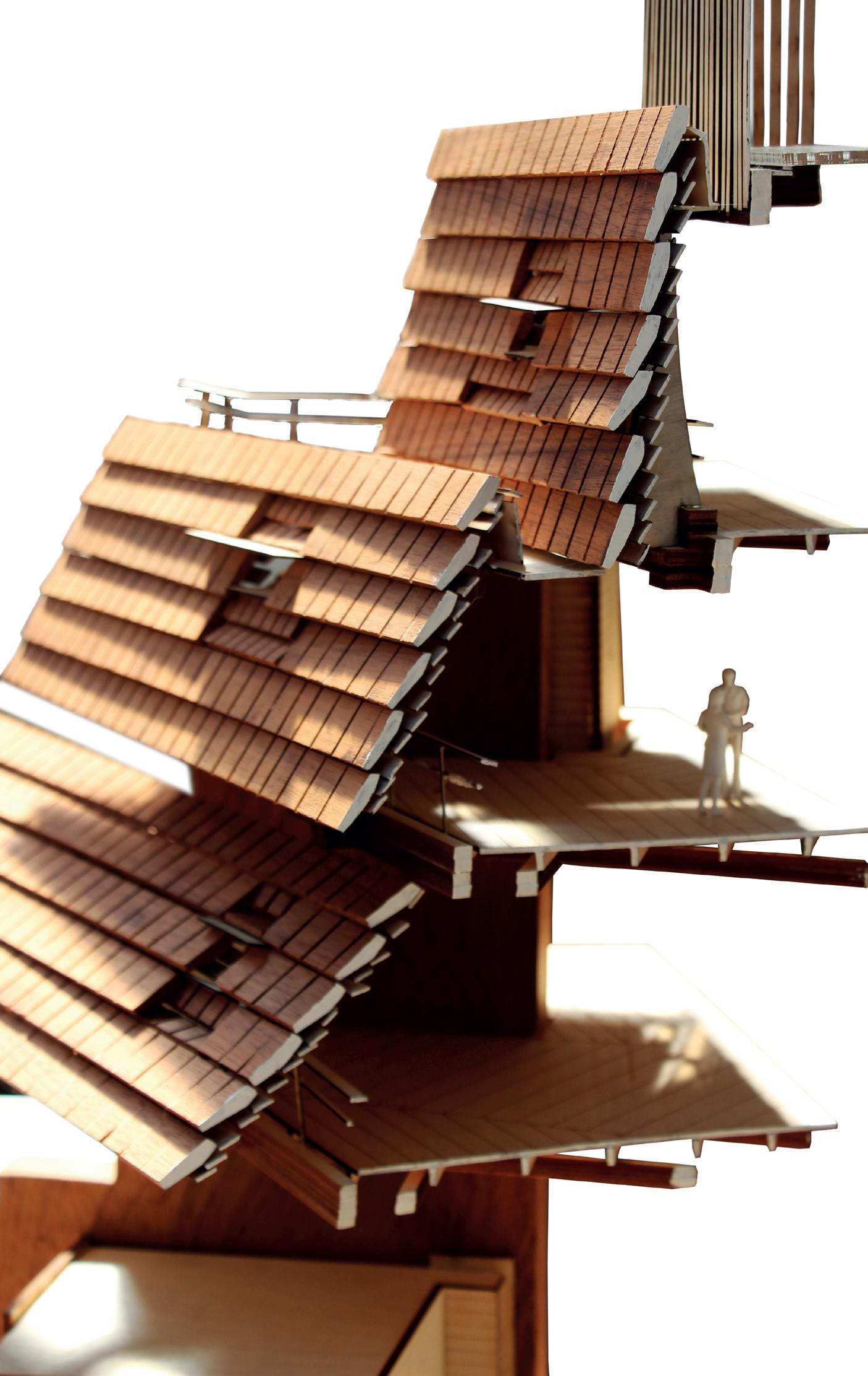
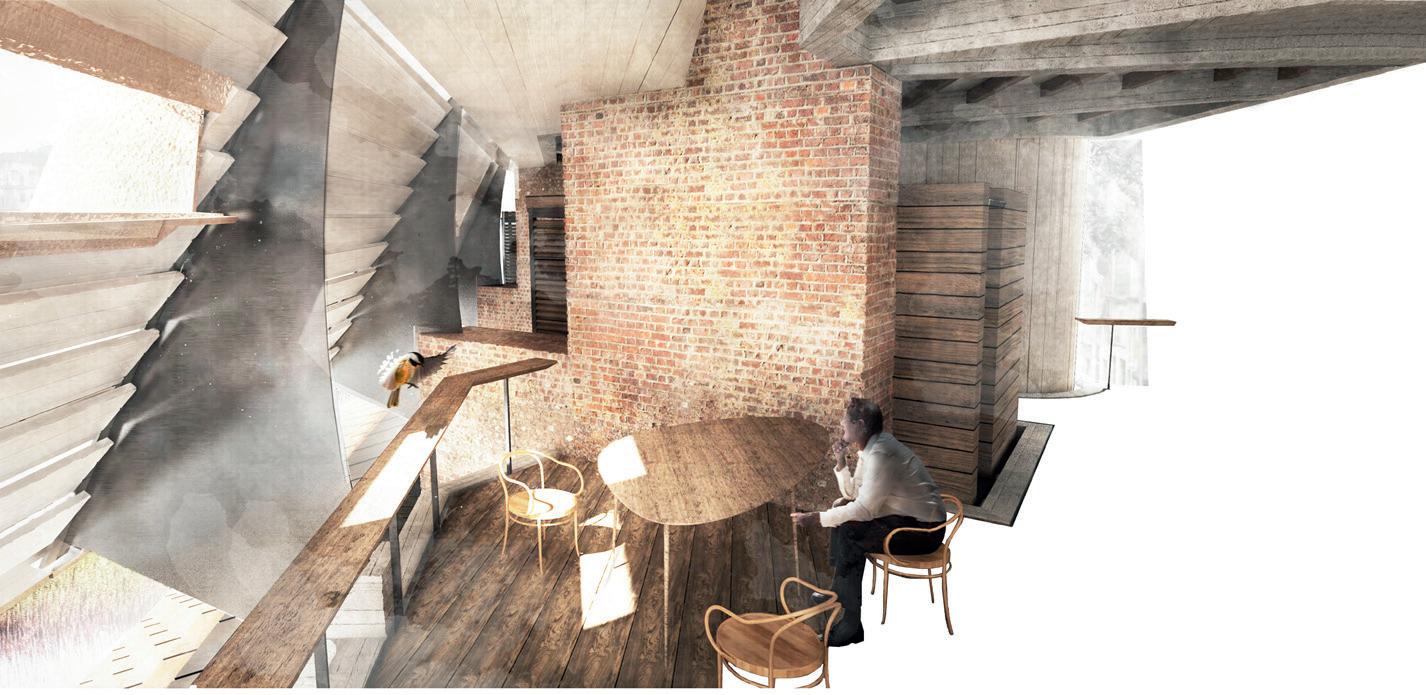
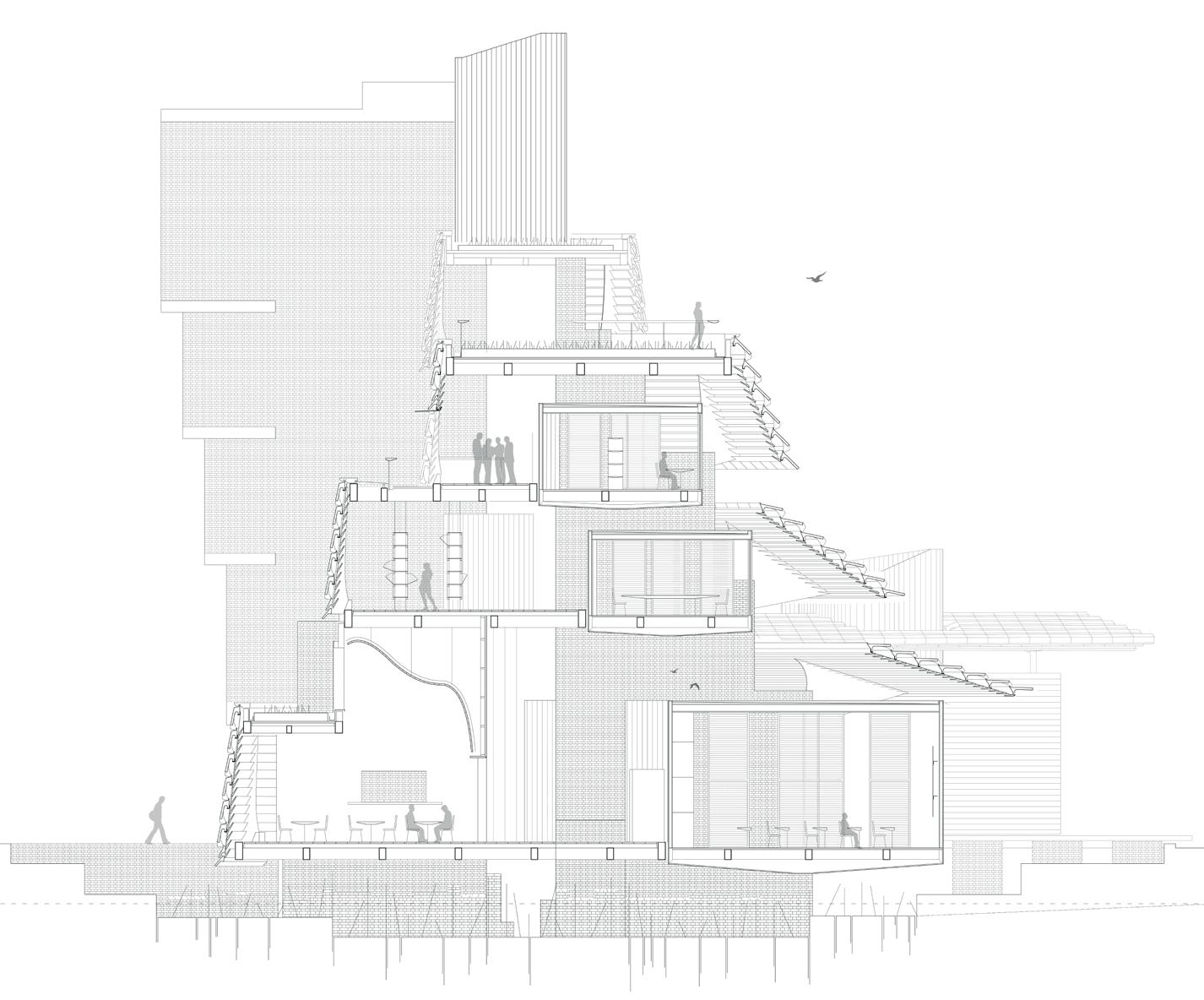
2 | Shared by Species 3 | Moments of Control




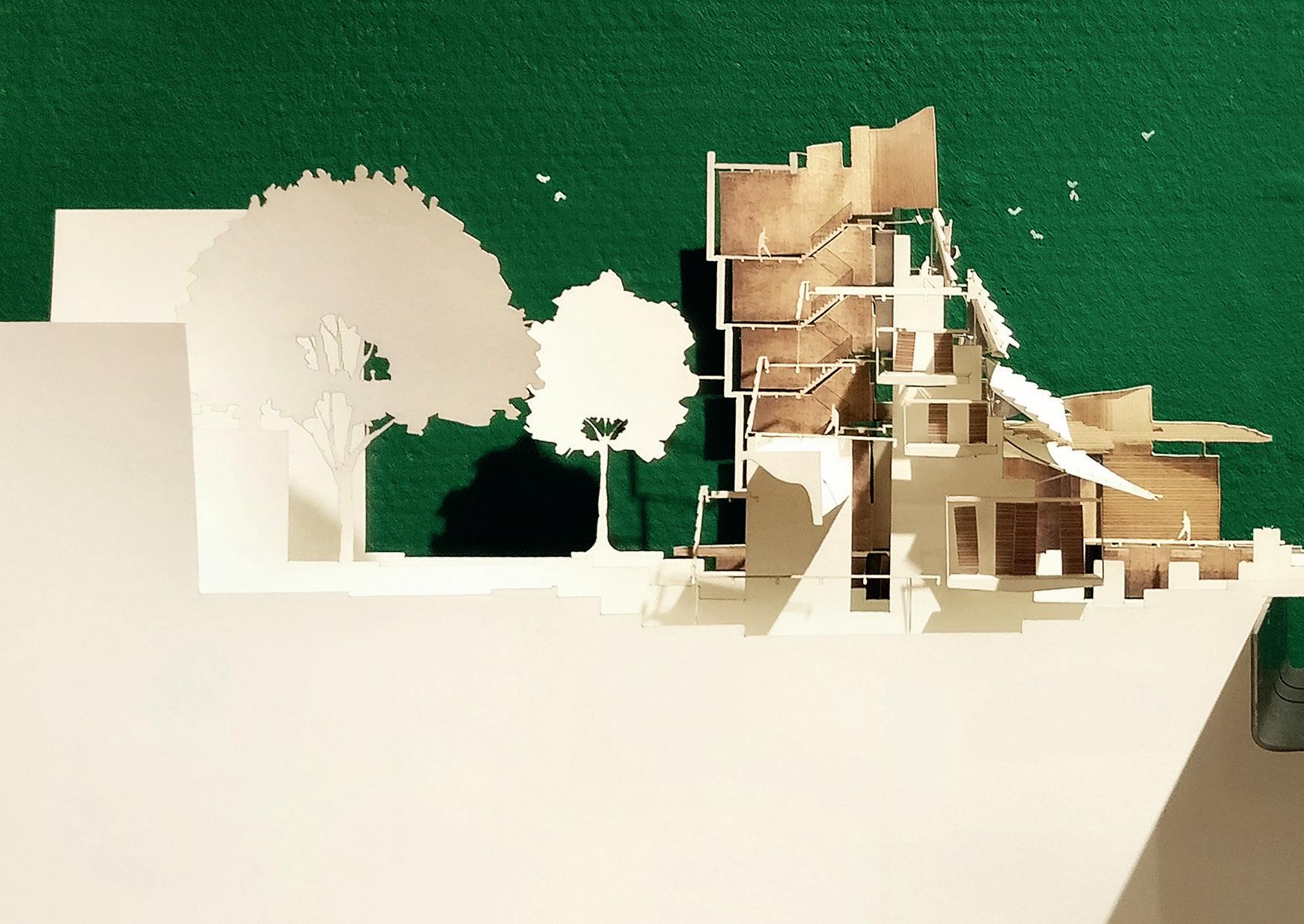

Kolkata appears to be in a state of barely stabilised wreckage. e governing powers of the city seem to act in a world of bureaucratic dryness. In an ocean of wetness, these powers seem unable to govern the contested territories between the private entities and the ‘public’ districts of the city.
is project identi es some of the contested territories between o cial power agencies and public spaces in the wards which they govern. e project plays between the literal wetness of urban fabric and the metaphorical dryness of the bureaucratic powers, tactically, literally and metaphorically, saturating local conditions of governance with performative wetness in the form of new public amenities.
Scripting these territories and their associated armatures, the new Architecture comes in the form of tectonic characters, derived from satirical sketches of Bhadralok plays of the Bengal Renaissance, which mediate bureaucratic, cultural and water technologies together as interplaying aspects of component assemblages of the new democratic urban apparatus. ese situations happen in 3 primary sites around the northern districts of the city.
SUDS (surface water drainage systems) act as stages, at various scales, upon which the performative wetness soak into both the literal physical and the metaphorical cultural landscapes. e main guration of the ‘actors’ are as clouds, vessels and satirical masking: various ways of playing out and mediating the newly negotiated territories.
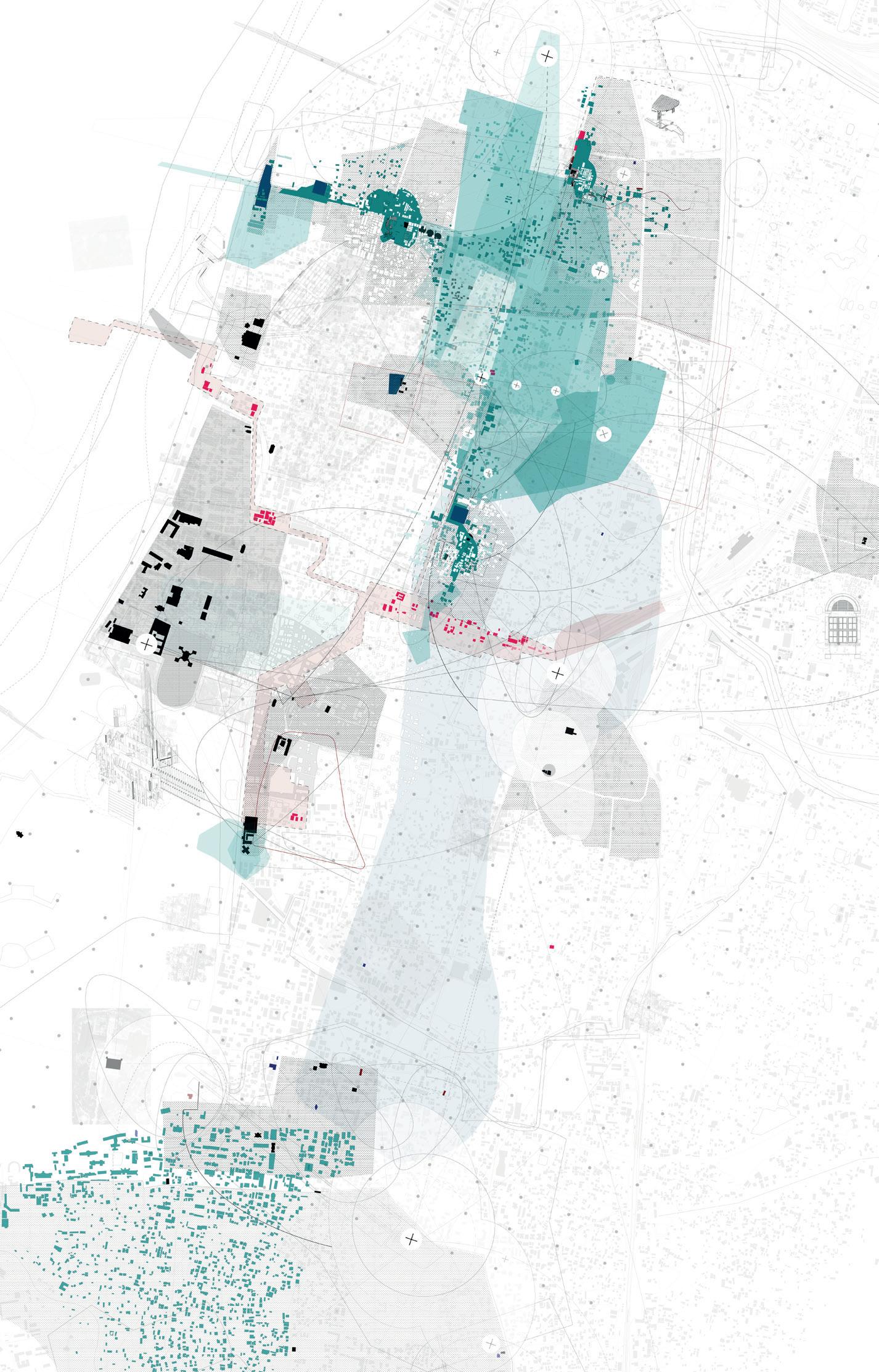
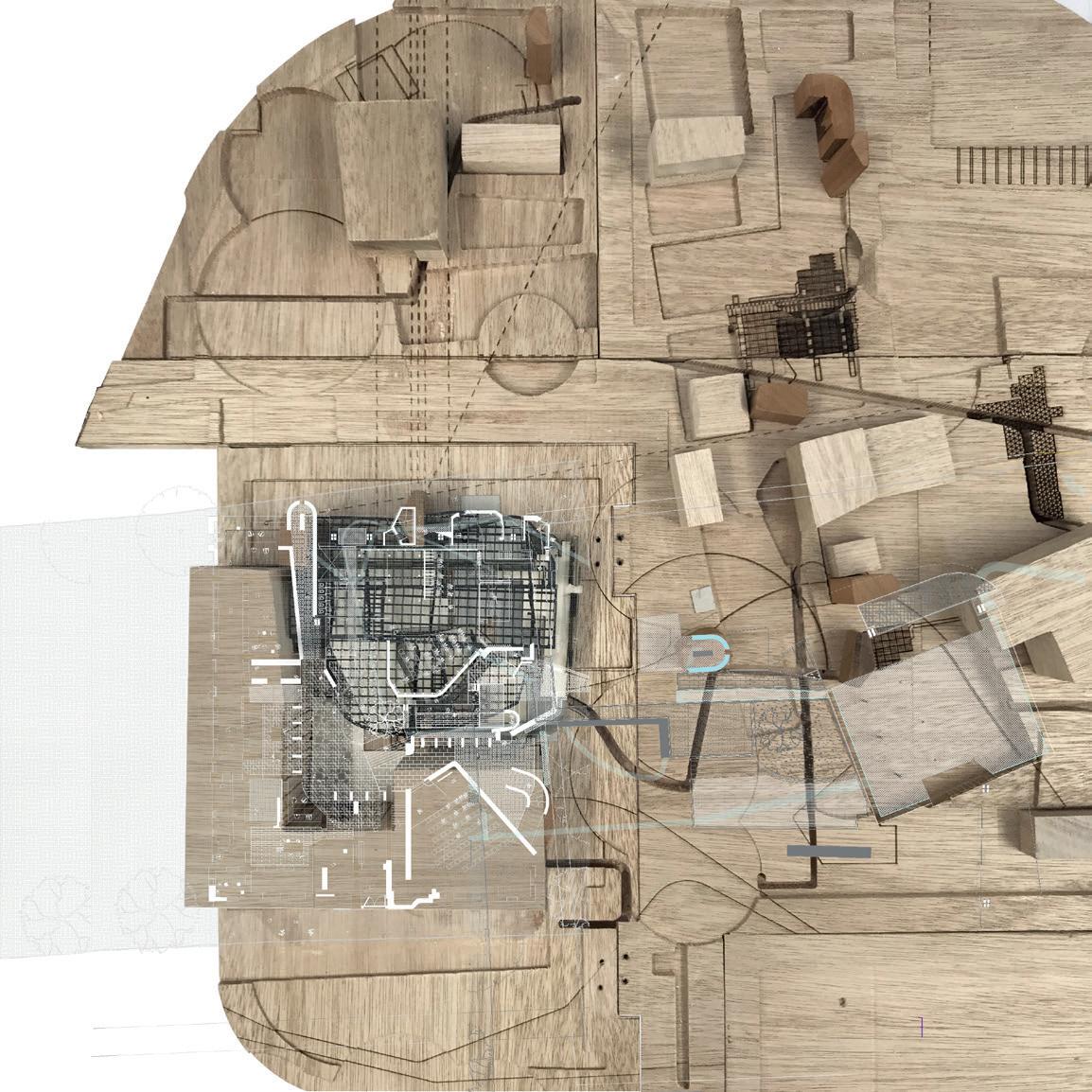


SABRINA SYED
“ e context was a city in which things were being disinterred and dislodged from their moorings, and being washed ashore by an imaginary tide.” 1
Amit Chaudhuri describes Calcutta, submerged and shifting in what we call an “Ocean of Wetness”. e architecture he describes takes shape through the houses of the Bengali Bhadrolok – whose writings shaped the city. However, these dwellings and their architectures are disappearing, erased through combined forces of avarice and neglect. Kolkata’s authorities have allowed these textured sites to be attened. e languages of the “nook”, the lush, polished red oxide “walkways” and the circumsepting “moats” are being replaced with yet more buildings of nonplace. With them goes the intelligence they fostered, surrendering to erasure. Realestate driven projects ignore the possibilities of working alongside Wetness, yet are inhabited by populations whose experiences are steeped in it.
e thesis seeks to reclaim Calcutta’s narratives through architecture that works alongside both literal and “literary” Wetness. Using a vocabulary of architectural elements from the original “parent” dwelling, the proposals seek to develop them through a network of writing institutes that strengthen and develop buildings as “Ecosophic Objects”. e Writer’s Institute in Kidderpore, and the New Alipore Press each “hijack” a site of contested nature within the city and insert a new writing agency within it.
e sites also operate from a new “second nature”, guided by the thoughts of Dilip da Cunha and Anuradha Mathur in ‘ e Jungle’s Call’: in order to create “wetness architecture” 2 and reject the land-water binary, the role of the jungle as an existing condition of Calcutta is revealed again, both literally and metaphorically. erefore, in each agency, there is a careful consideration of when the jungle is architecture and the architecture is jungle. Each institute is a clearing in its own jungle. ese “jungle” territories act as new public programs which literally and metaphorically re-write themselves into the city’s urban consciousness.
1 | Amit Chaudhuri, “Calcutta: Two Years In The City” (London: Union Books, 2013).
2 | Dilip da Cunha, The Jungle’s Call, HarvardDesignMagazine, No.45, 2018.
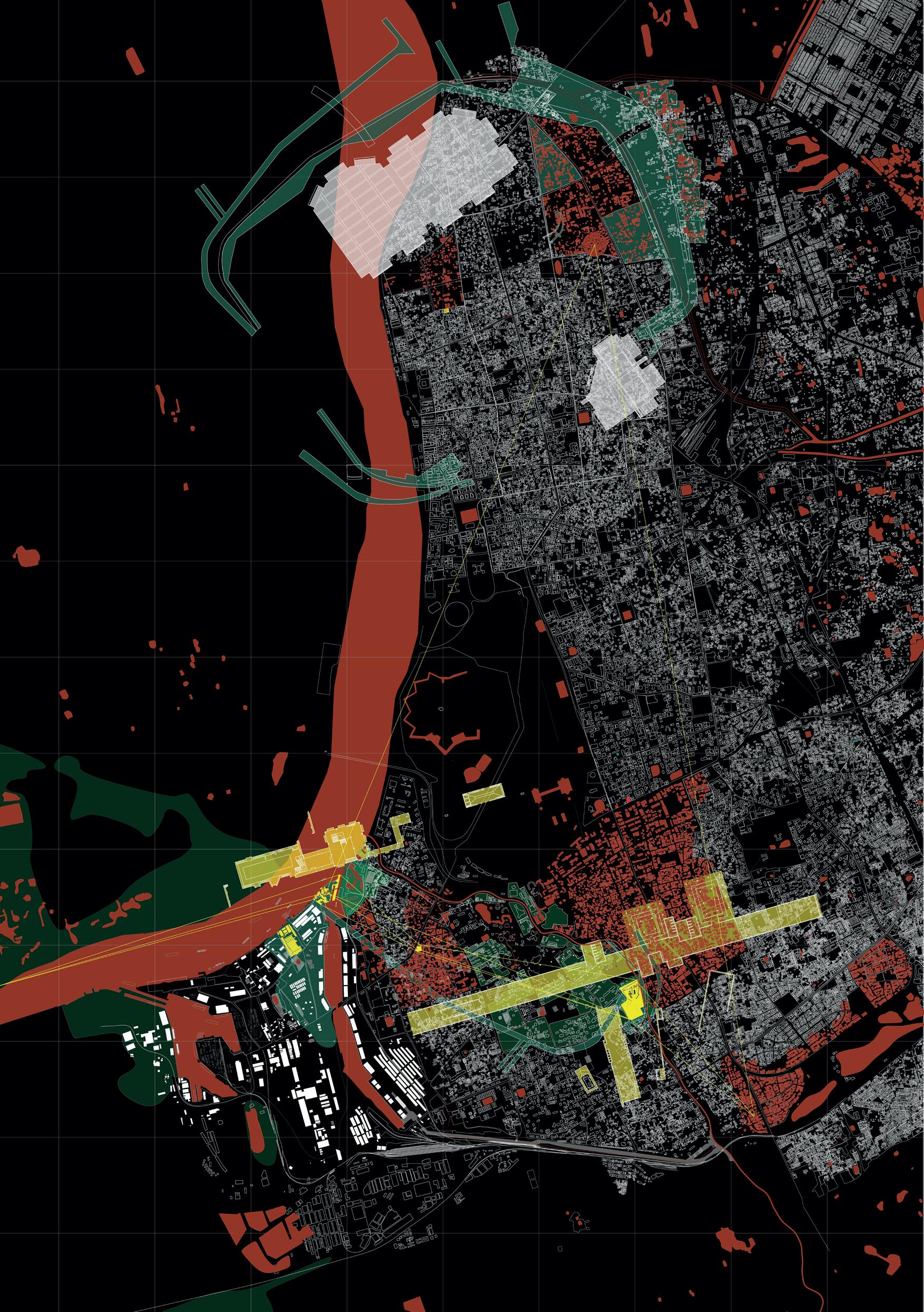
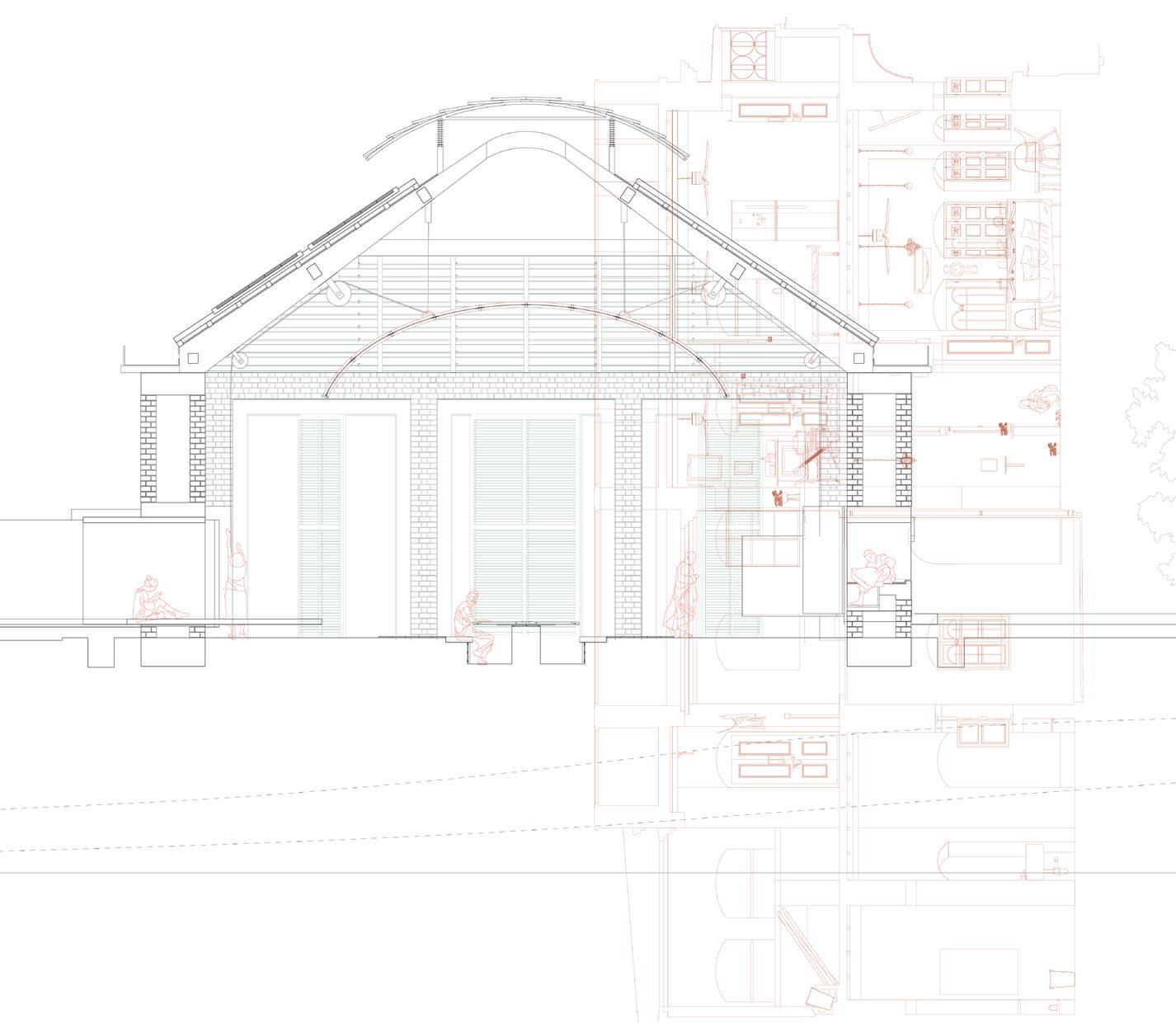

ANDREW CHAVET | KATE LE MASURIER
An irony exists between the two thresholds of Calcutta’s chaotic pavements.
On the kerb side the ‘Inside-Out’ inexhaustible activity of streetside commerce spills out onto the road: textiles, woodcraft, pottery and metalwork, a hive of sustainable handmade production gives hint to the wider intricate economic wonder of Bengal.
On the building side - behind the saris and sandals in adda on rawks 1– a backdrop of pealing plaster, exposed brick and engul ng plantlife has left the once ‘City of Palaces’ as an architecture in decay. At the mercy of the ‘Oceans of Wetness,’ humidity and moisture are returning the city’s soft clay structures to the bed of the Hooghly.
is juxtaposition of handcraft potential and urban neglect, however, o ers a perfect opportunity for speculative architectural policy. Having lagged India’s epicentres of economic growth, Calcutta – the sub-continent’s cultura-intellectual capital – can avoid the acontextual construction practices that have revolutionised swathes of the country’s re-urbanising cities. Instead, like a contemporary ‘City in Evolution’,
Calcutta’s existing architecture can be understood as the sca old for the next:
a sca old that encourages site by site speci city, where bhavan are part retained, part renovated, part replaced, crafting a city in ux; a sca old that advocates a climatic sensibility, reliant on tanks, butts and channels as the parti-pris of wetness design; a sca old where no drawn masterplan takes command but rather supports an economy of interdependent small-scale suppliers and craftspeople; a sca old whose unique locality preserves Calcutta’s urban identity and celebrates the zest of the city’s pavement culture.
1 Wiszneiwski, “Much Adda About Everything” p.4, in this volume.

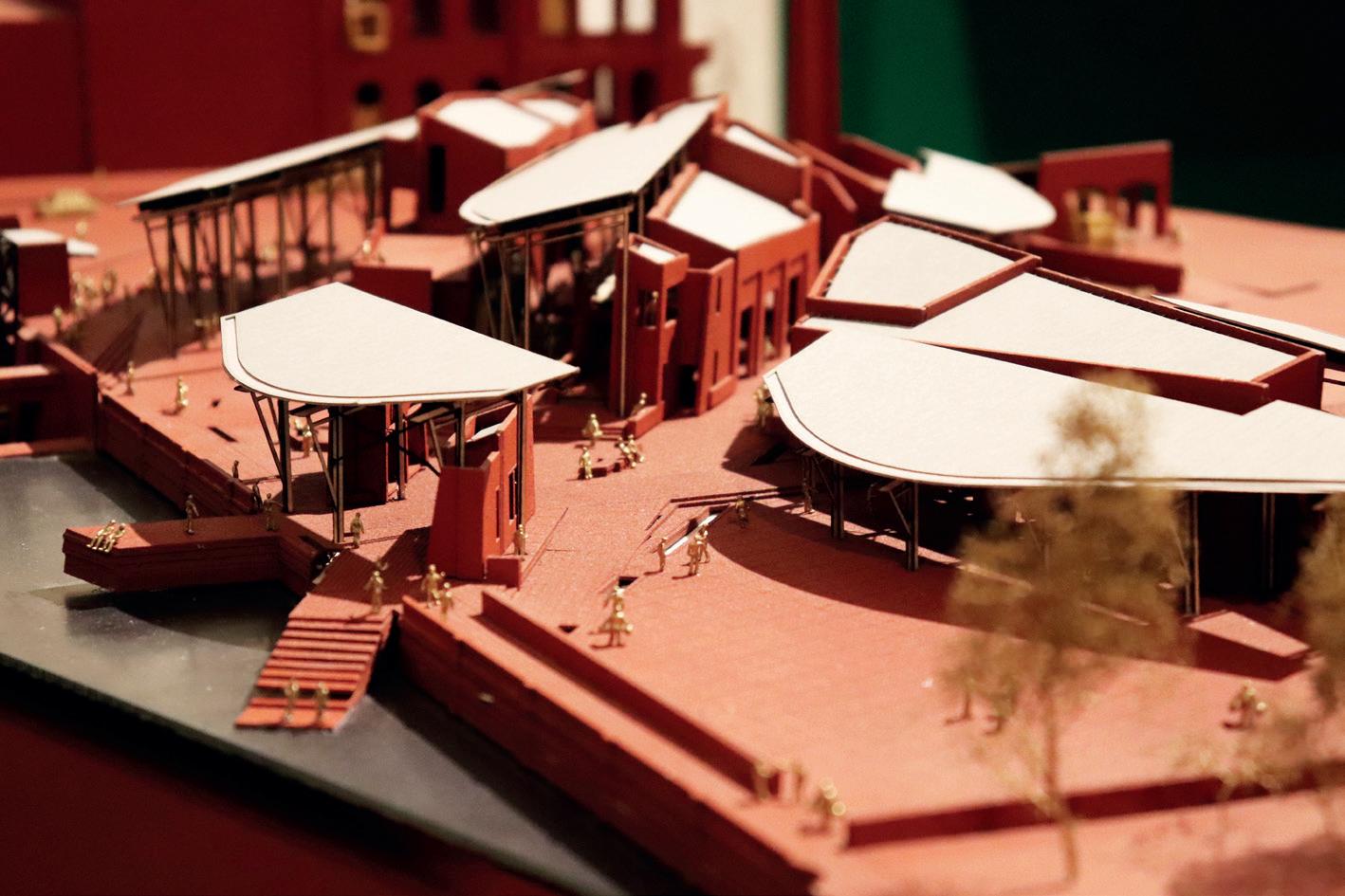
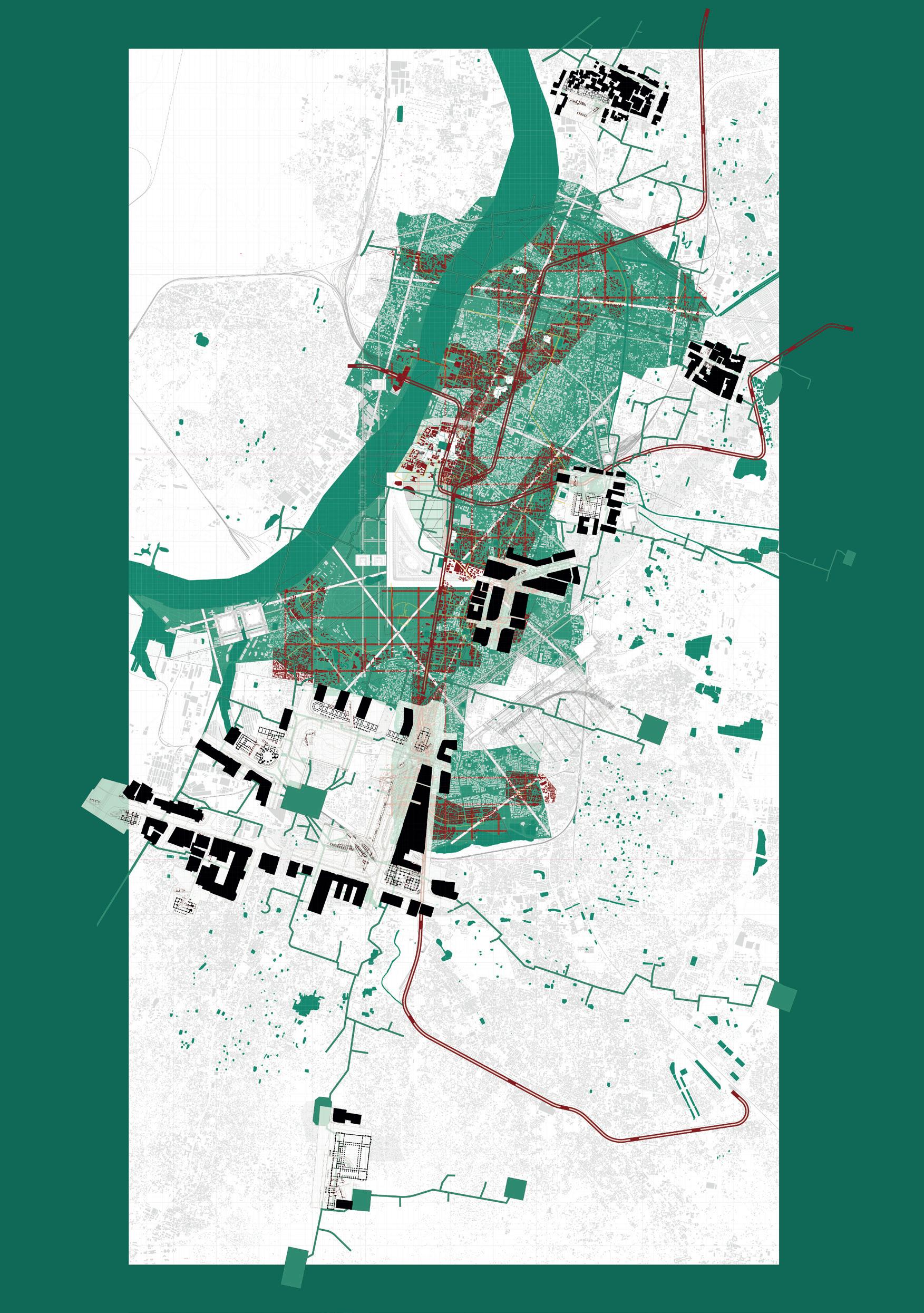



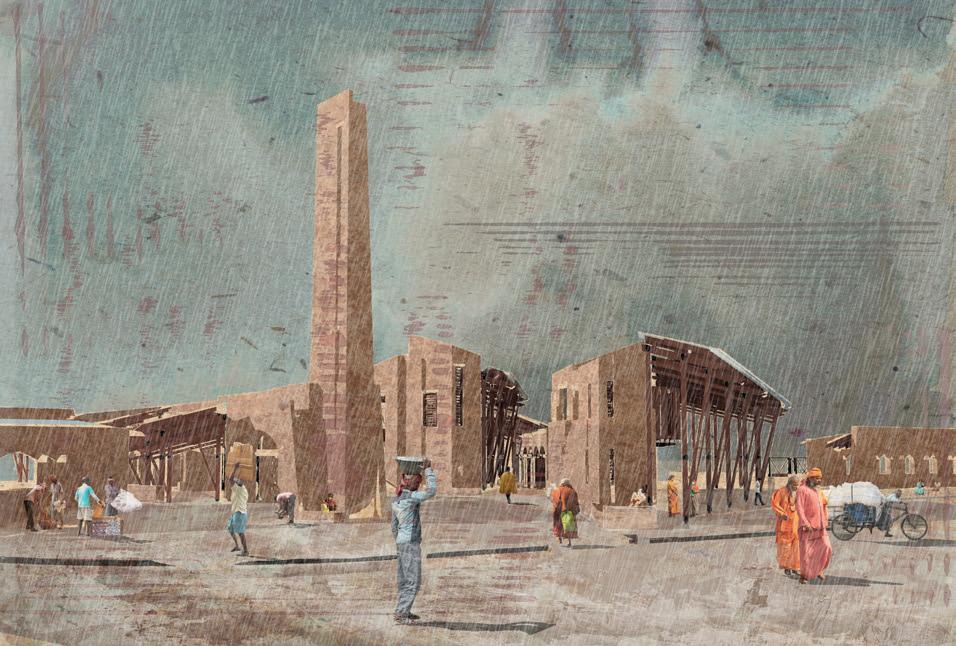


Boat Clubs tend to convey elitist views, sub-urban mentality, notions of wealth and exclusivity. Kolkata seems to encourage urban infrastructure built upon bourgeois amenities: social clubs and other privileged spaces are linked together as series of buoys oating on a surface of now fragmented colonial class-formed territoriality. In the South of Kolkata, e Lake Mall creates a distinction between the “up”market measure of privilege in the upstairs shopping mall and the “down”-market Ganga measures present among the shmonger folk at street level. In the North of Kolkata, the Tallah Tank echoes and represents parallel water distribution inequalities of Kolkata more directly through its re-appropriation, dominance and measure of nature.
Project Mayhem is an urban garden project that seeks to disturb current water and Ganga relations. e Rabindra Sarobar Lake presents a fecund ground for tactical rupture. A rowing track is proposed for the arti cial lake. It seeks to look beyond the handicap of water through aquatectural thresholds (Ganga’s Cast of Gags), using various social measures to rupture and redistribute privileged measure.
A series of kilns will re-appropriate the man-made garden ground (that was once swamp) to Democratic Huts, abiding by the precision of a rowing track. Urban Shuttering will provide a transition between Ganga measure and the conditions demanded by social measures. Ganga’s Cast of Gags will reveal a new garden biopolis to initiate a di erent Boat Club mentality for the bene t of all folk.

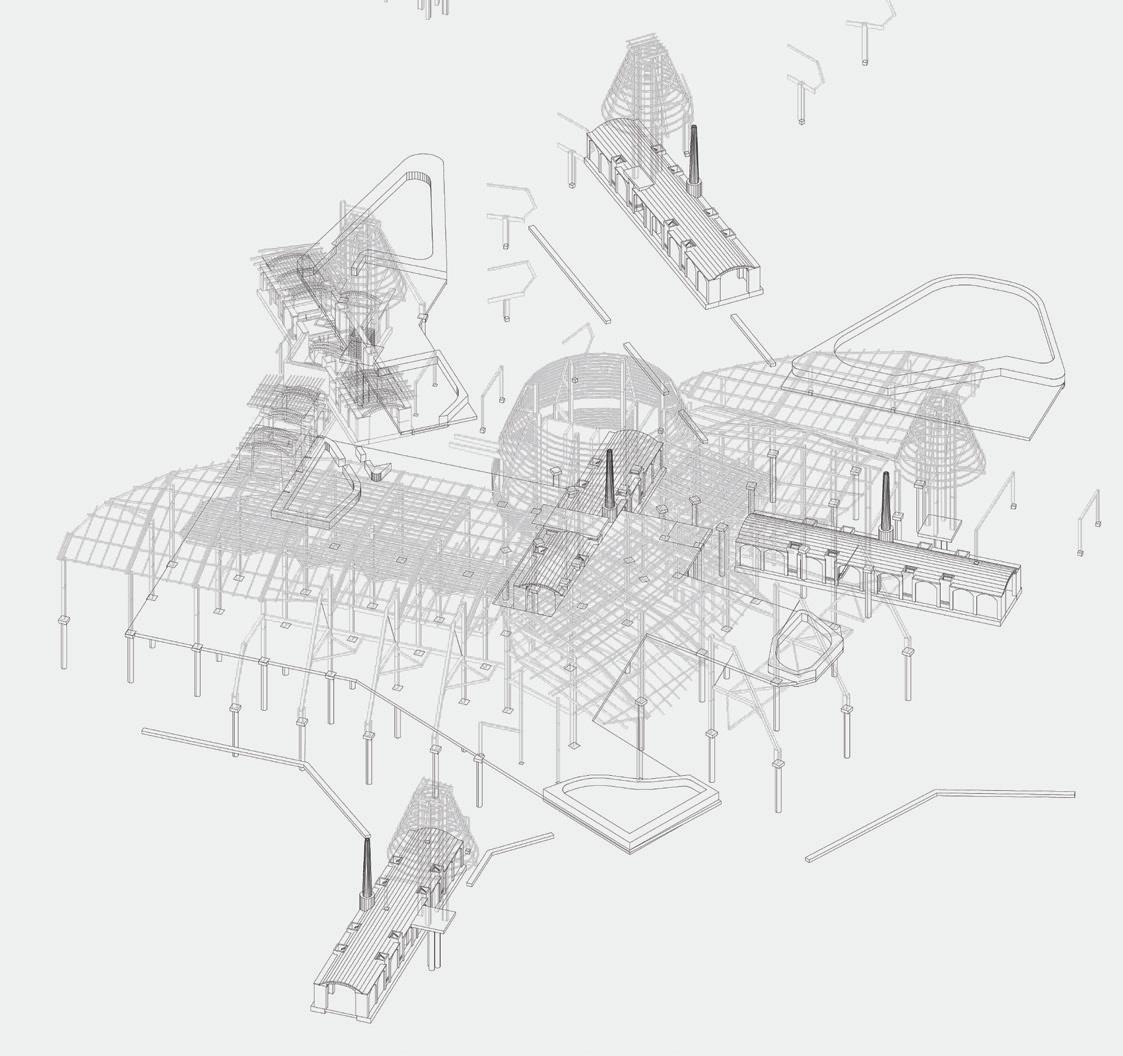


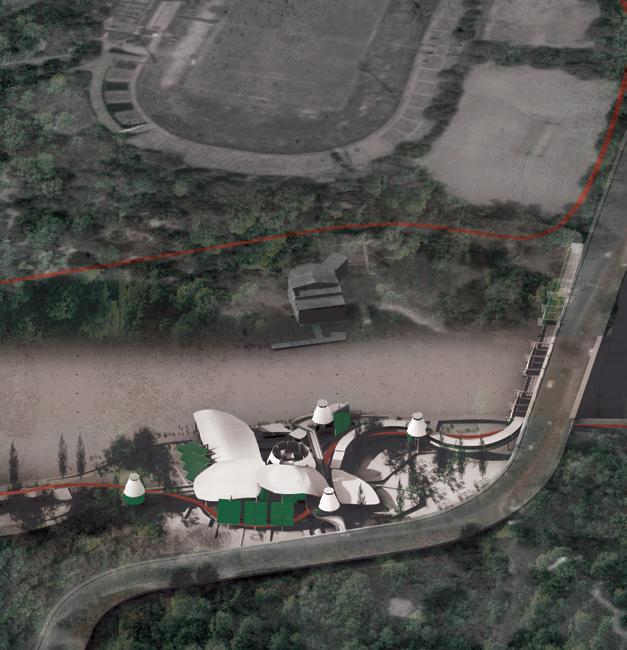
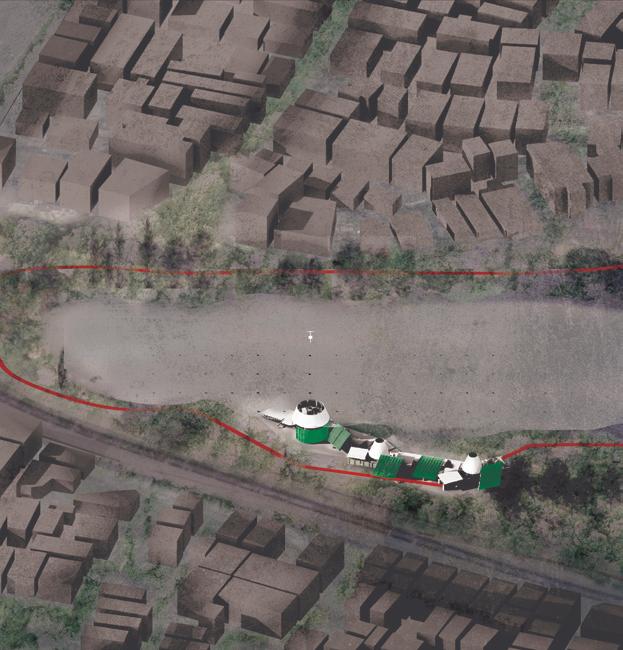
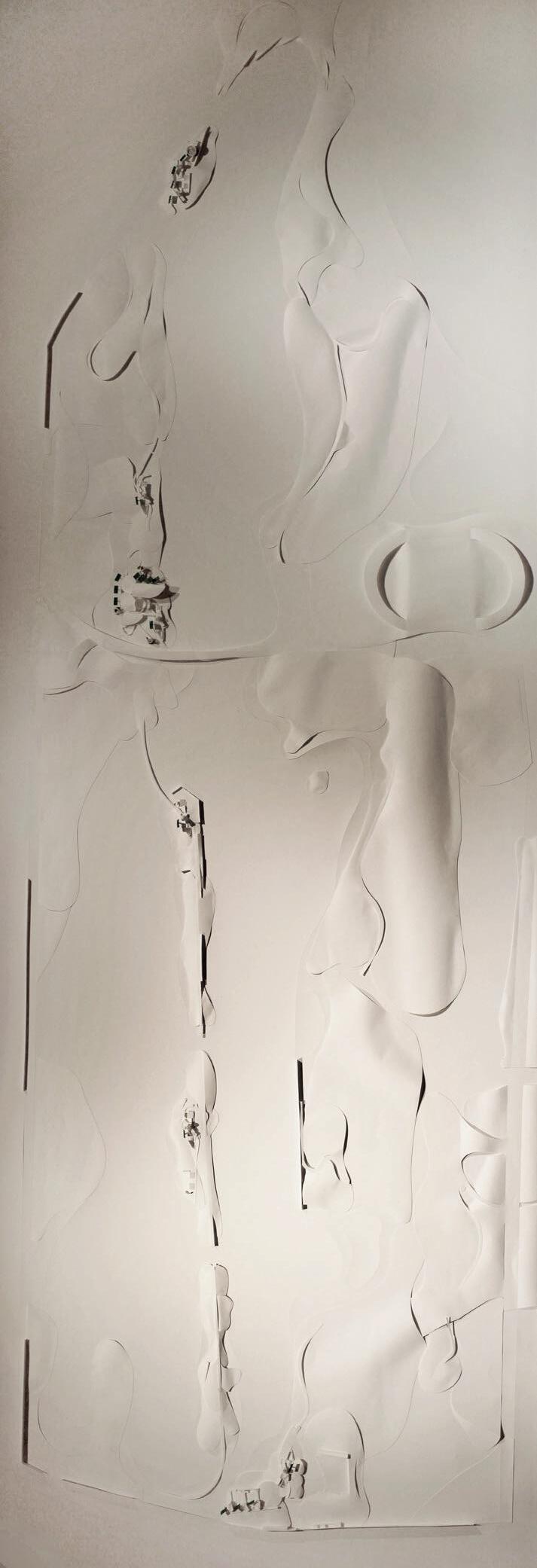





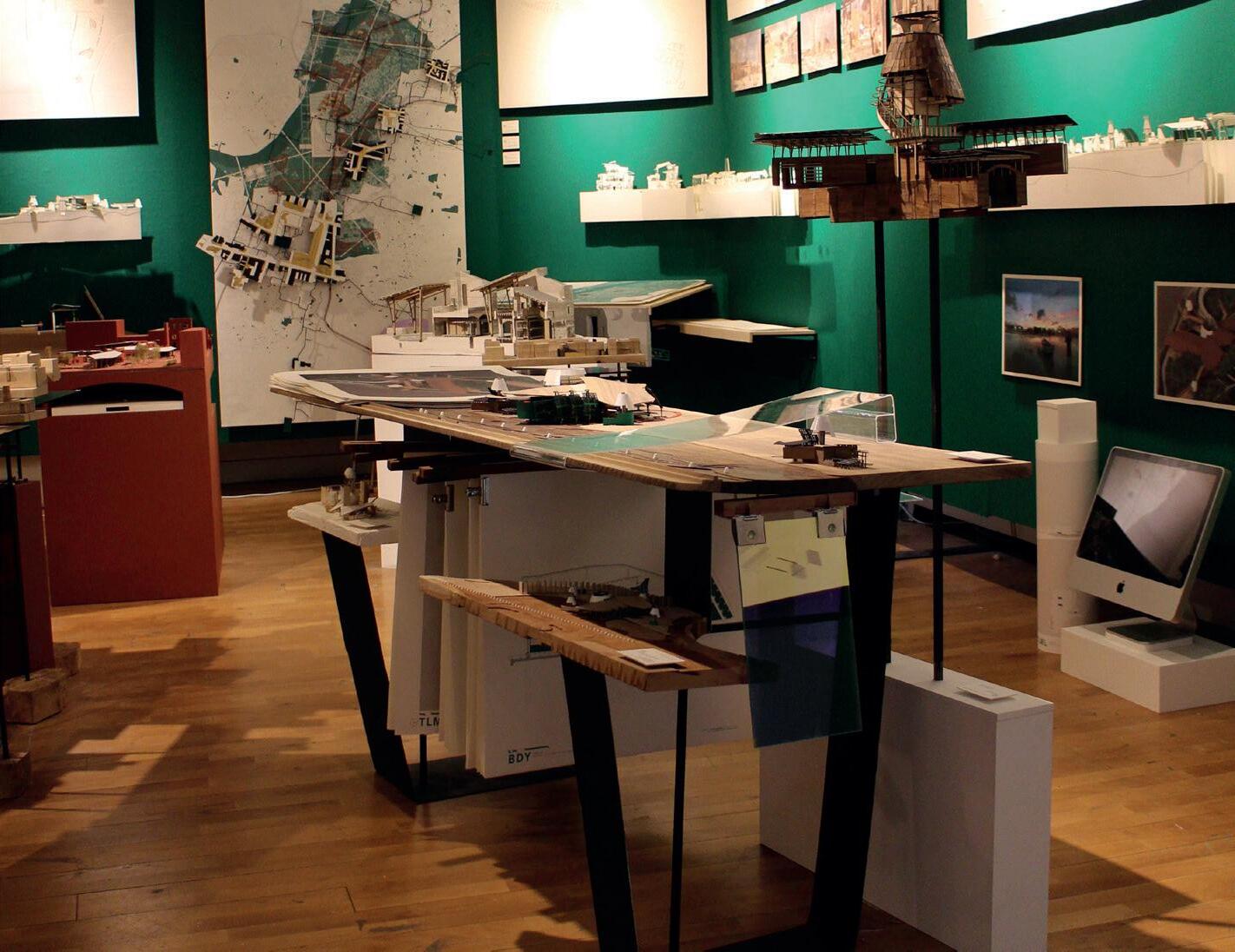


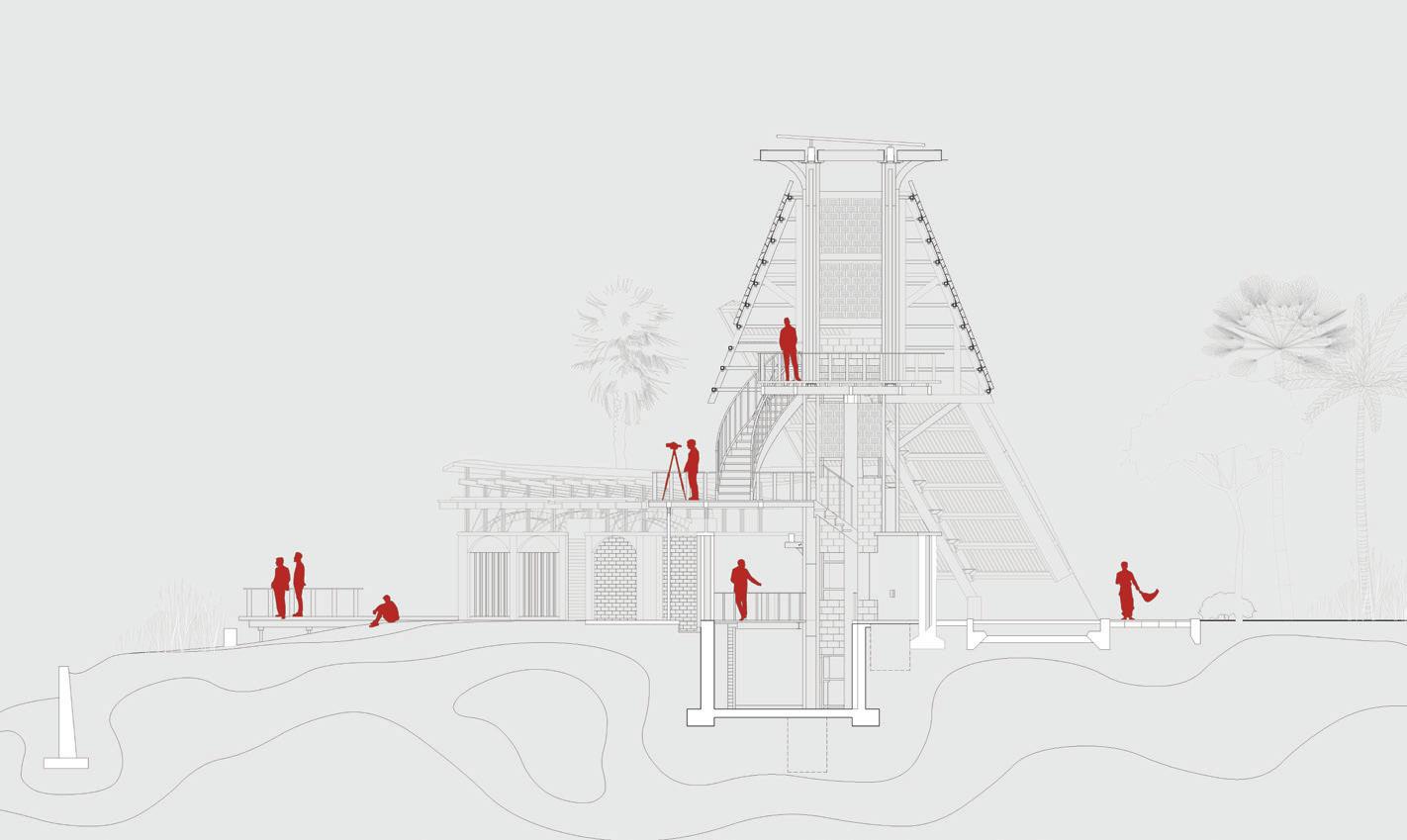
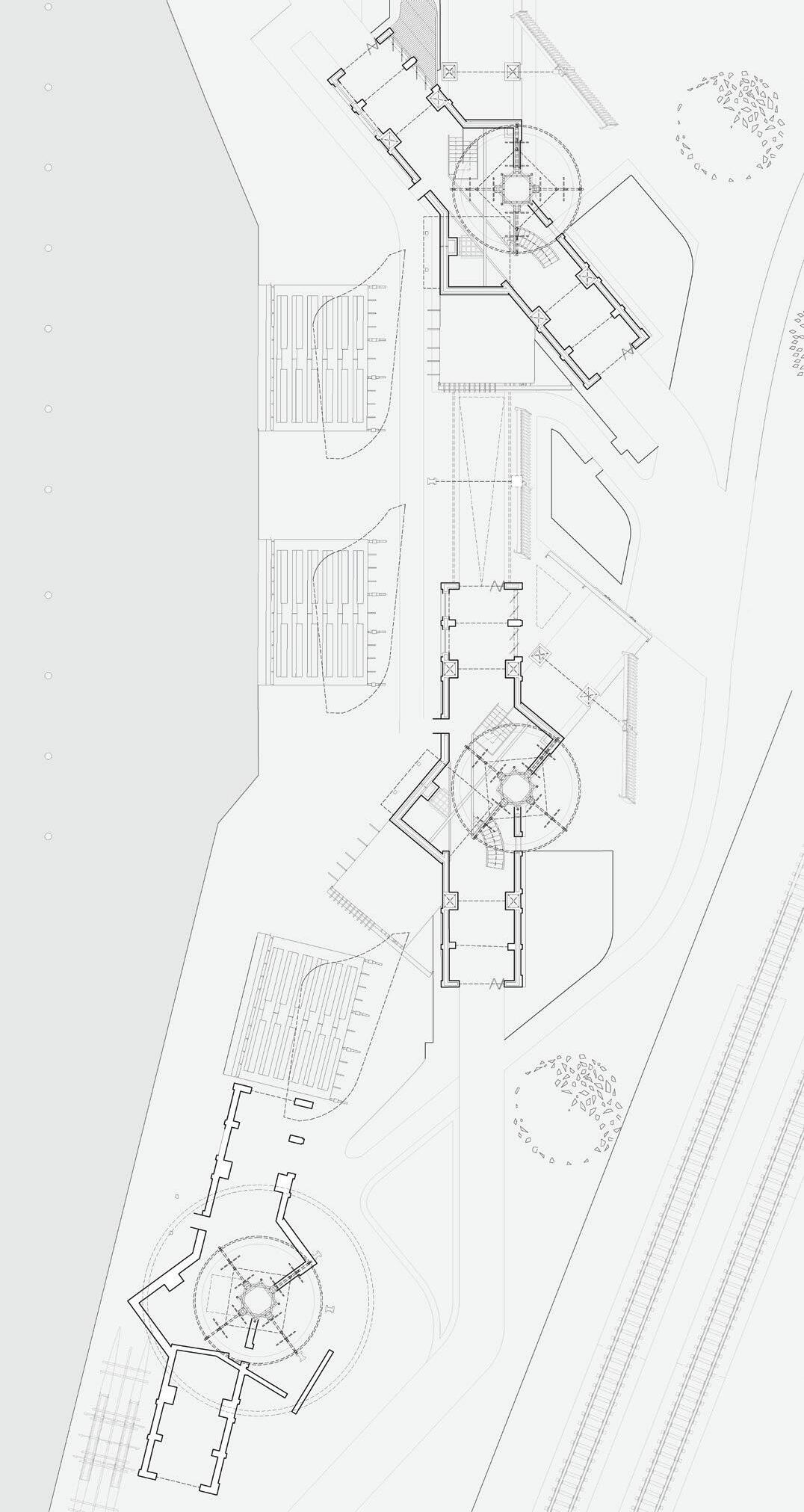


Kumartuli is the cradle of the Gods in North Calcutta. e clay made idols in Kumartuli are one of the oldest surviving handicrafts of India. e artists here are the people who bring the supernatural power of the gods down to the earth. However, contrary to its important position, Kumartuli is facing environmental, economic and social problems. In order to alleviate these problems, this project proposes to elevate the place in two ways: rst, by enhancing the recognition of Kumartuli as a speci c civic amenity of gallery and workshops for both residents and visitors; and second, by extending other social amenities across Kumartuli.
Always borne in mind is the importance of the legacy and ambience of Kumartuli. Based on the intense measurement of its special character, architectural recalibration brings new means to rethink architecture. e gallery and workshop is based upon existing “supernatural” processes found in the everyday workshops of Kumartuli. e new architecture accommodates the ux of Monsoon, it mediates the wet and dry processes, it Models space as the idol makers model esh, it Moulds clay and other materials of the idol makers into architecture, it Assembles parts and programme as clay body, each part Shadows others and respects a Sectional disposition locally and across Calcutta clay body-scape. It is both Epic and Filmic: experience is serial and episodic. Other amenities, like bus stop, port, Kurmartuli playground and the potter’s home further echo these super-natural relationships.
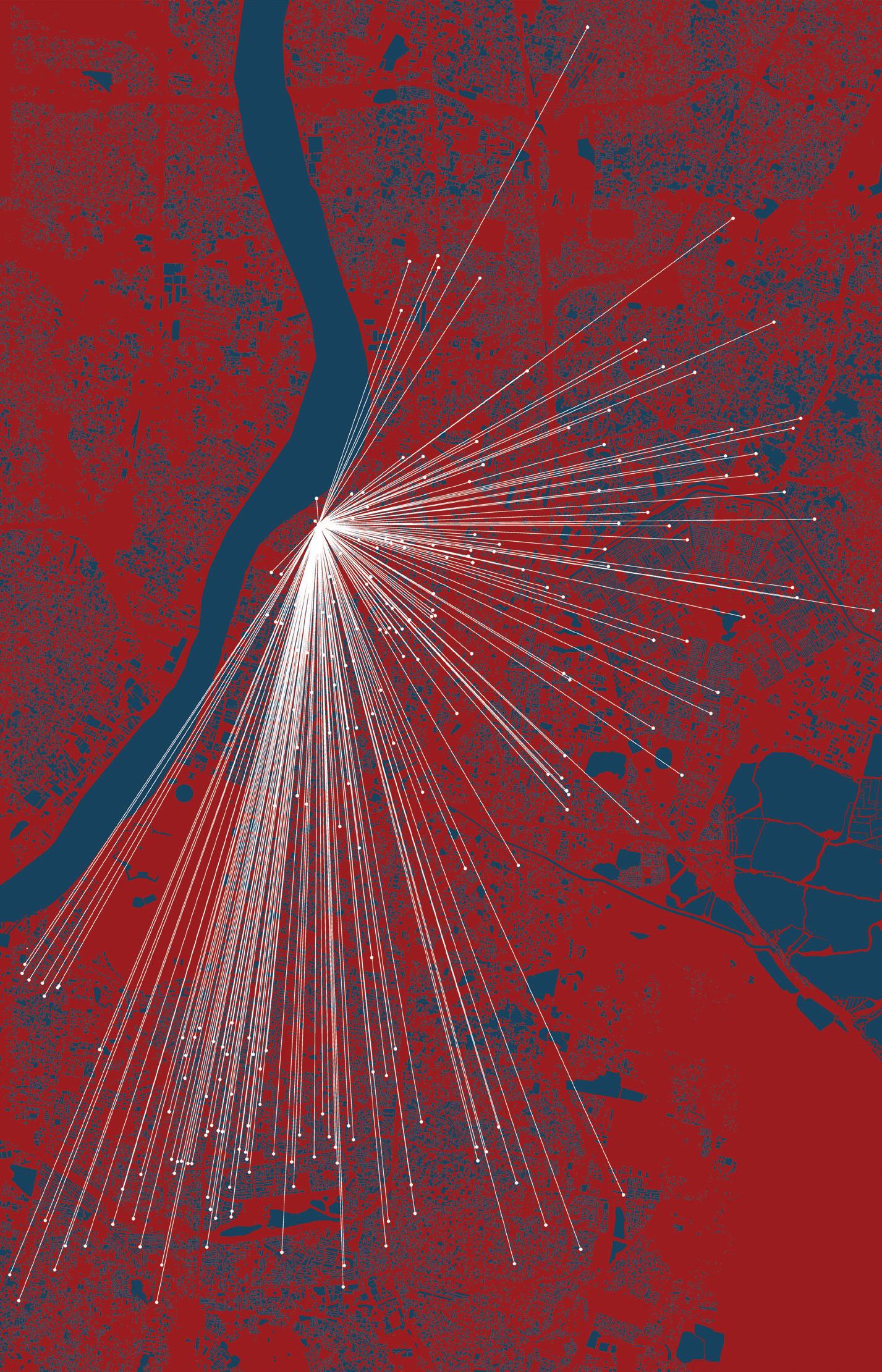
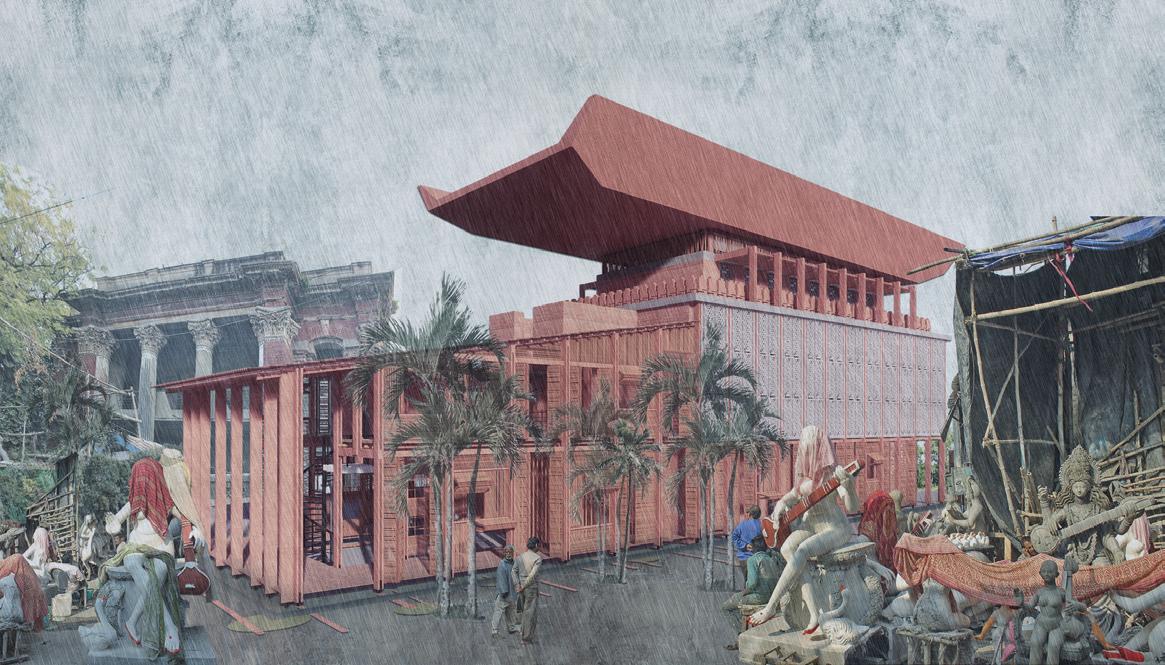


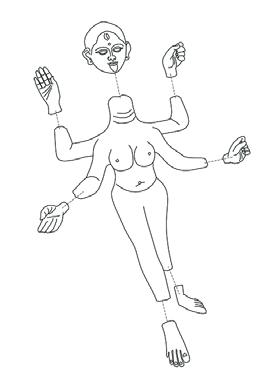


5 | Exploded Axonometric of Original Workshop
6 | Exploded Axonometric of Kumartuli Gallery
In reading a city like Calcutta, one can get lost in the multi-layered frenzy of its ecology. It is key to note that the way the city operates can be read through the study of concentrated clusters.
Such an example can be found in the meatpacking hall of the S.S. Hogg New Market: where animals, children, butchers, motorcycles and other amenities coexist within close proximity to each other. e hall is an “ark”, sitting within a landscape of the market, where various vessels interact with it on a daily basis. e ark in this project is paramount in reading the architecture of the city, where each building/individual is a vessel, sifting through the landscape of Calcutta.
Judging the e ectiveness of each vessel is hinged on its hybridism and its accommodation of the elements within its ecology. In trying to create a new architecture (ark), it is important to consider Calcutta as not the dehydrated at table that it is, but as a layered ocean which must be assailed through programmatic and tectonic considerations. e building/Ark created in this project serves as a point of analysis in which to investigate tectonic, political and ecological relationships.
e methodology of this research started with an investigation into the relationship between Rabindranath Tagore and his correspondence with Patrick Geddes. is close, interpersonal examination allowed for research not only into Calcutta as a physical space but a mental one, grappling with its colonial past and bureaucratic present, in the hopes for a more democratic future within those cracks.
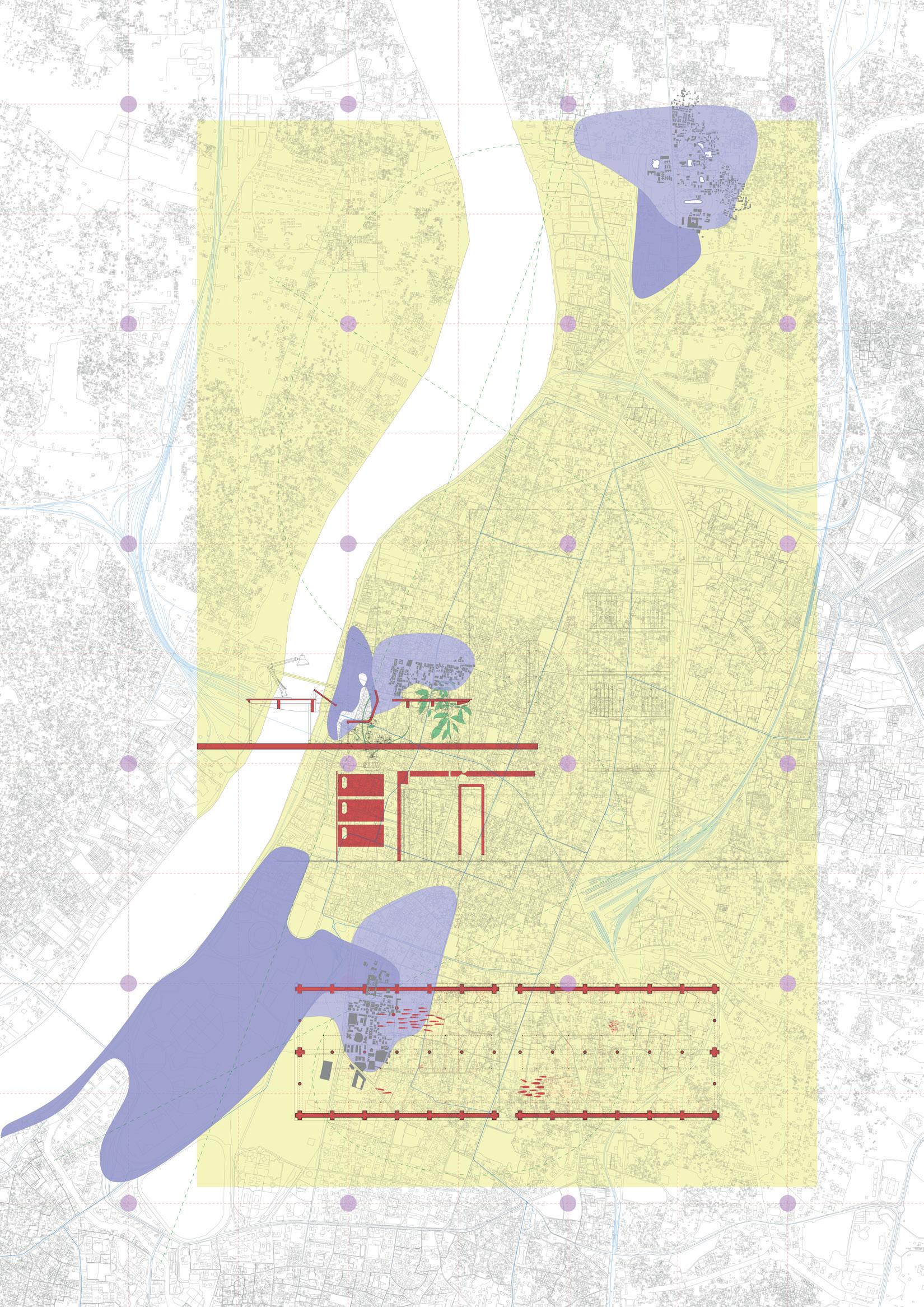




Painting Calcutta’s Ocean of Wetness | Minto House Entrance
April 2019 | Sabrina Syed
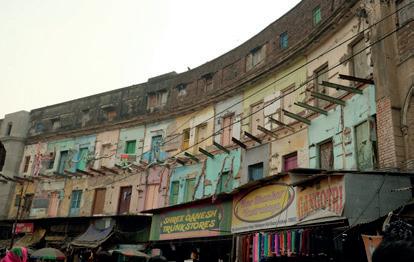
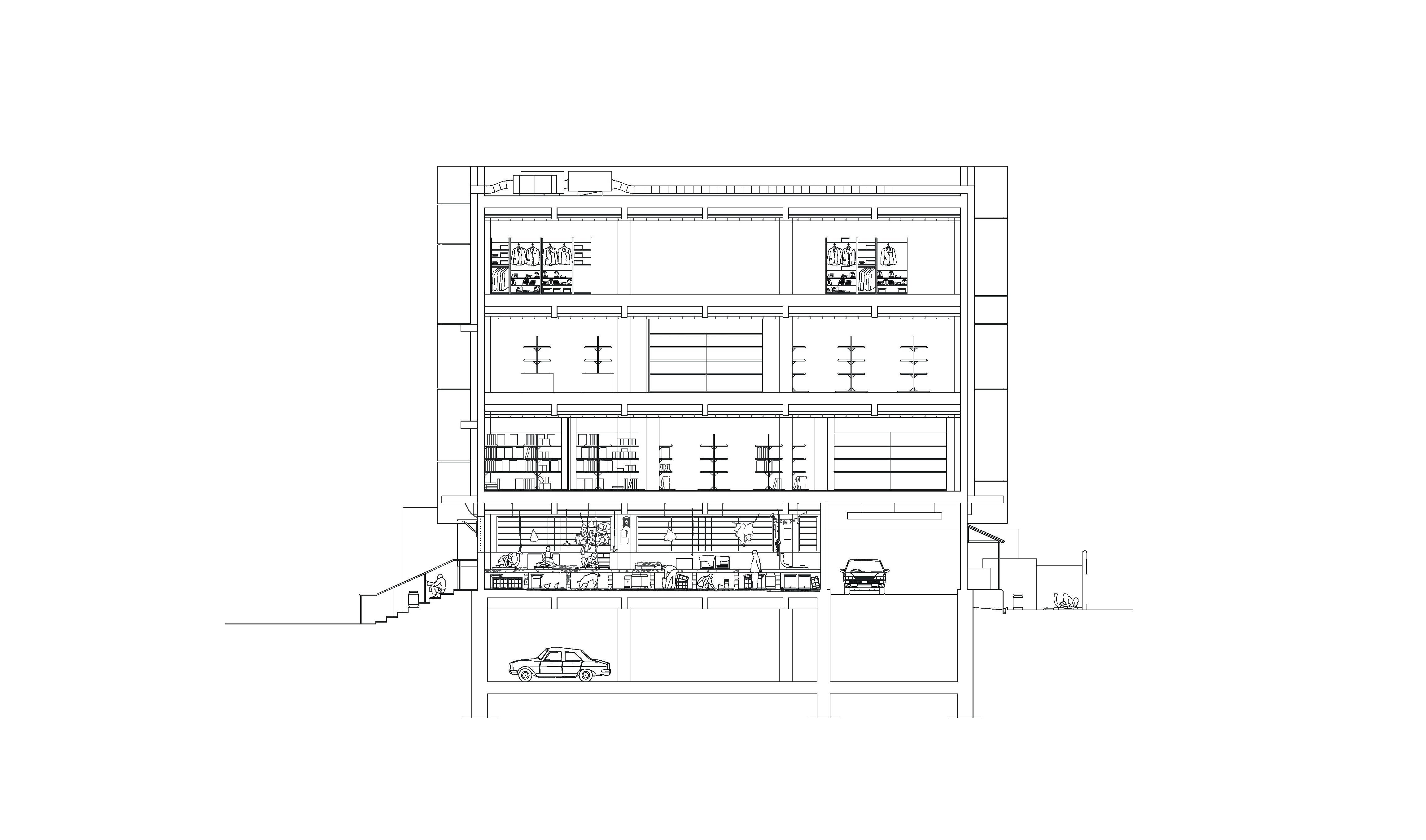

| Section through part of the Lake Mall
| Detail Section through part of the Fish Market
Fish Market through the Day




KHIDIRPUR


1 | Side Elevation of a Man Pulling a Rickshaw
2 | Kidderpore Market Entrance
SOVABAZAR
RUOTIAN WANG | DAANA BOLOT
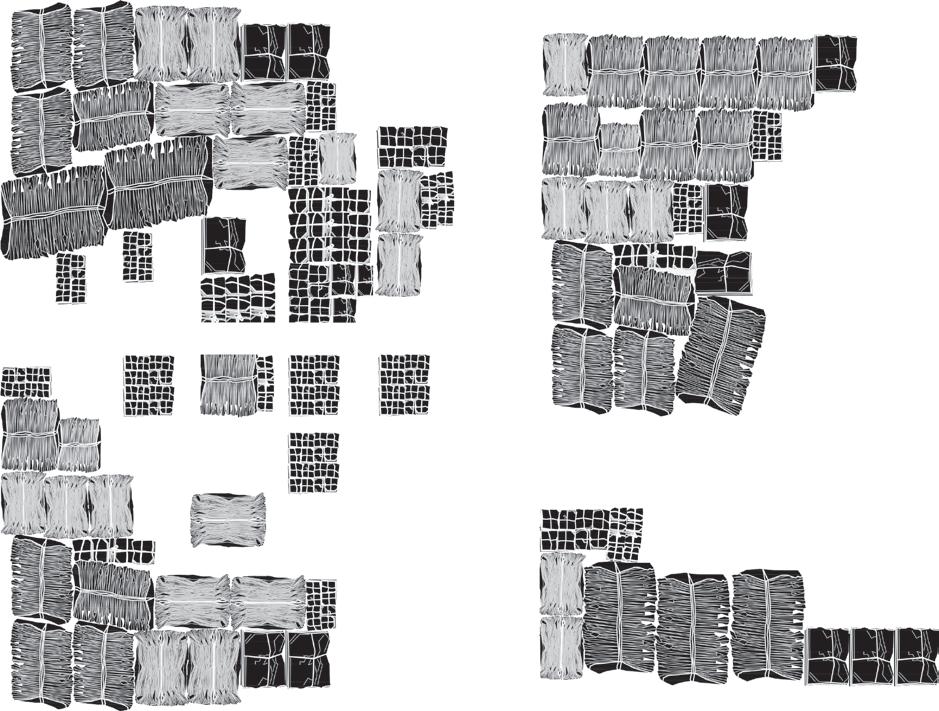
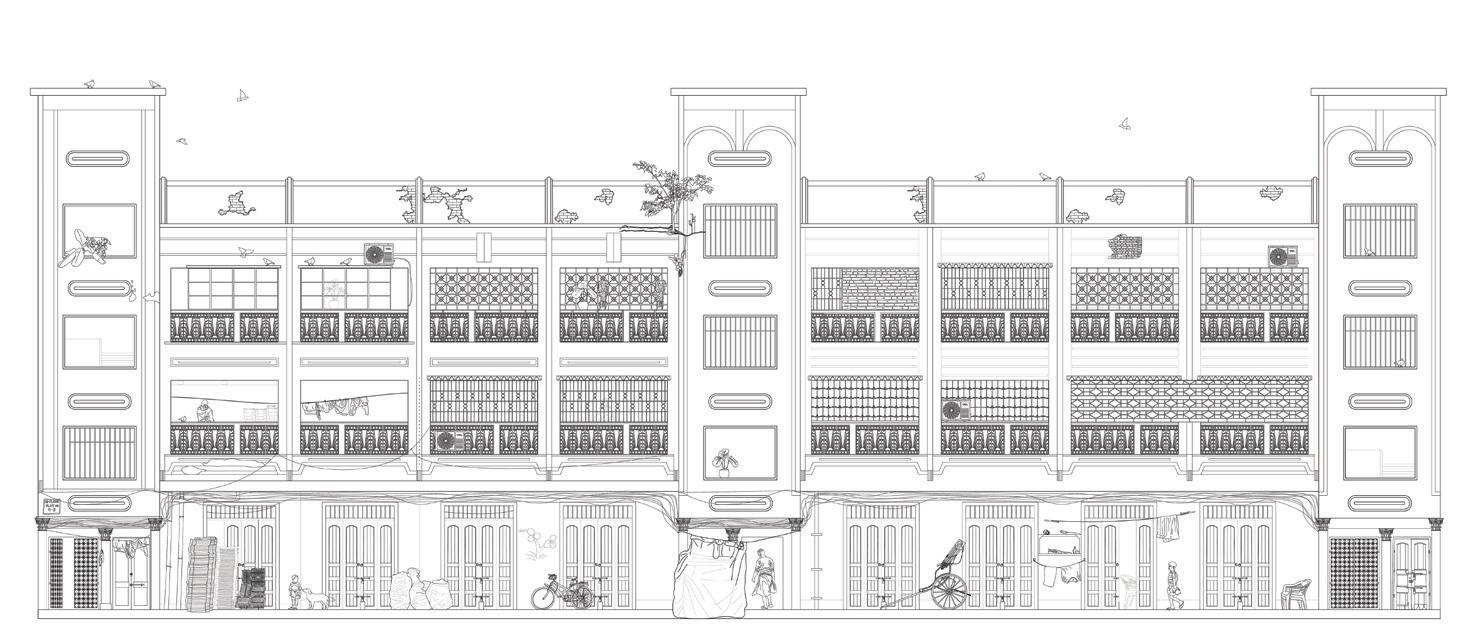
B.B.D. BAGH
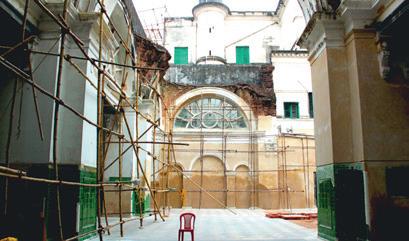
1 | Axonometric Study of a Pendentive
2, 4 | Front and Side Elevations of the Currency Building
3 | Ground Floor Plan of the Currency Building, with Kutcha Elements in Colour
5 | (Overleaf) Exploded Axonometric of the Currency Building and Abhay Mitra Street
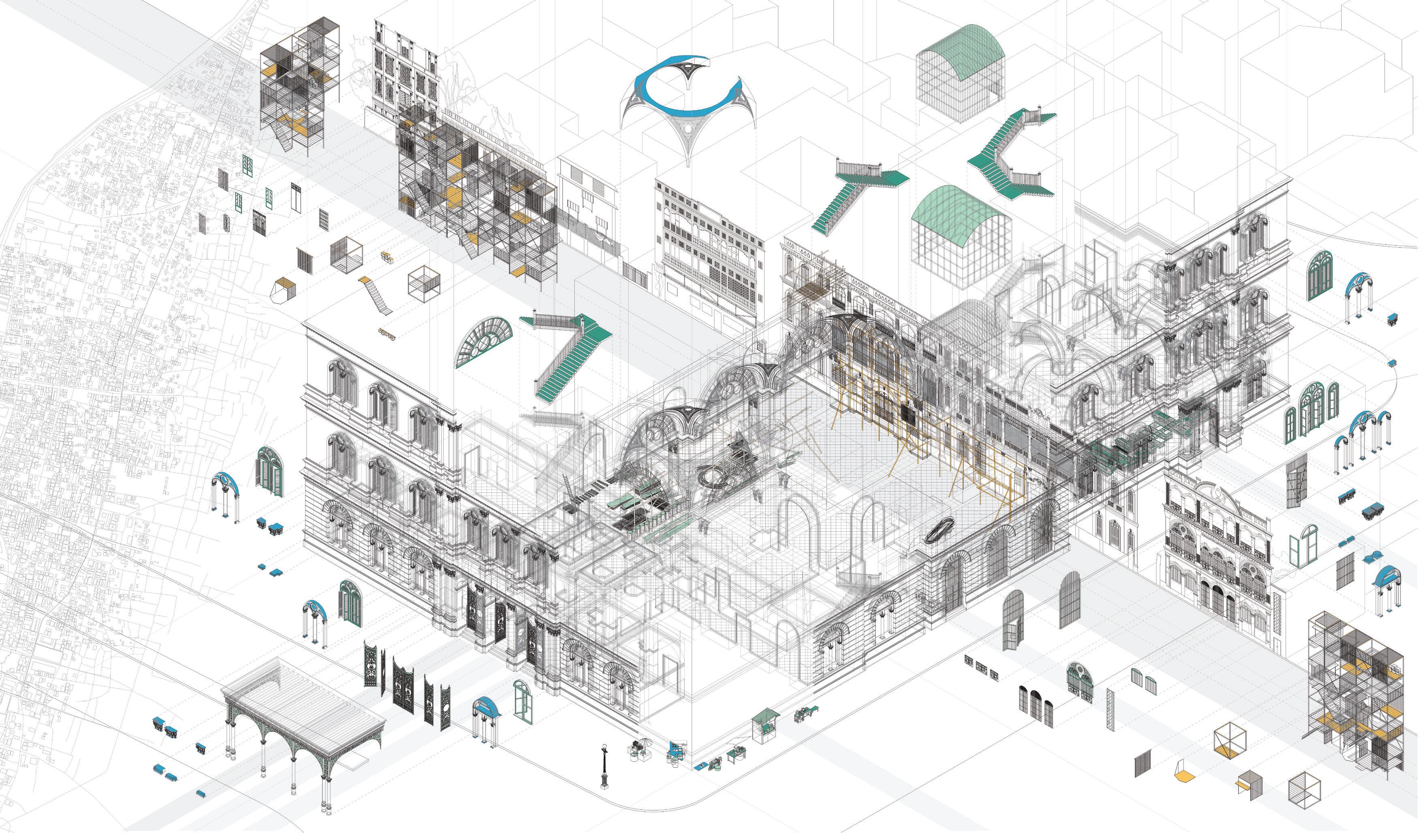


New Market | Sen Gupta Sarani
January 2018 | Gbeke Akinkugbe

DHARMATALA
GBEKE AKINKUGBE

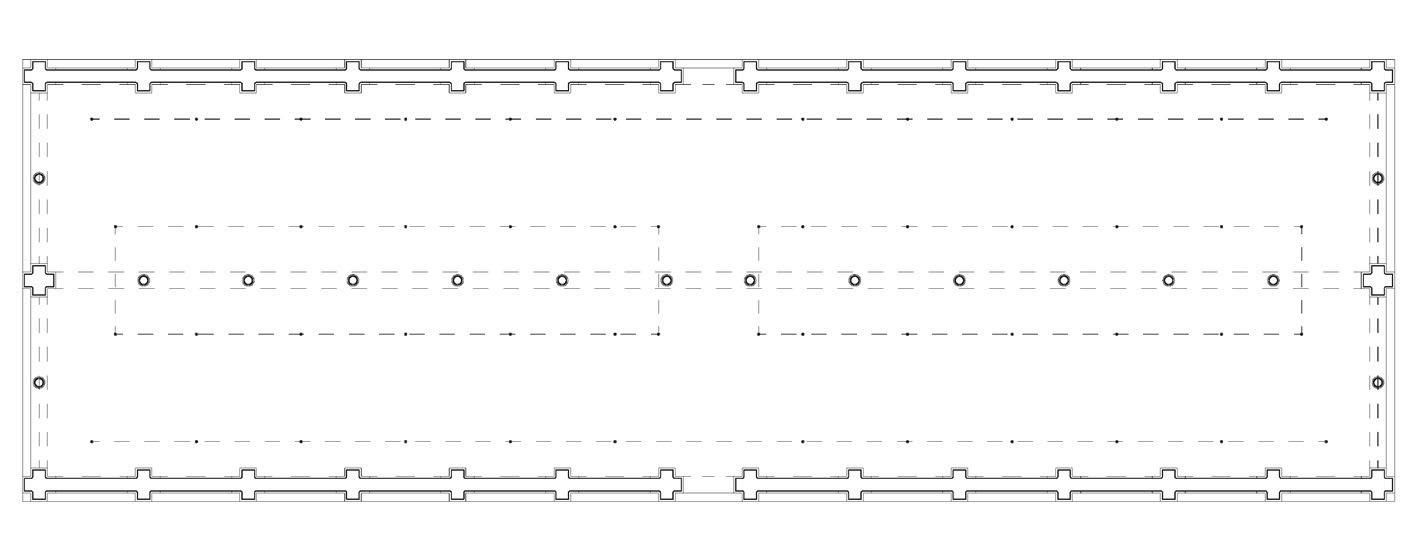


Waiting in Howrah Railway Station | Howrah-1 January 2018, Desmond Chang

HOWRAH
DESOMOND CHANG
1 | Isometric of part of Howrah Station
2 | Mapping Maldo Farm
3 | Section through part of Howrah Station 4 | Section through Maldo Farm and Distribution Building









1 | Section through the Hooghly River, Howrah Bridge Elevation
2 | Armenia Ghat and Zenana Ghat Complex Elevation
3 | Howrah Station Ferry Terminal Elevation


06 | 07 | 08





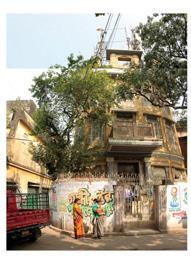

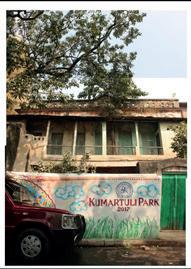
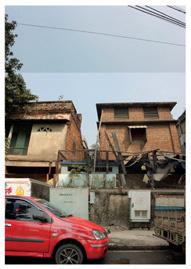
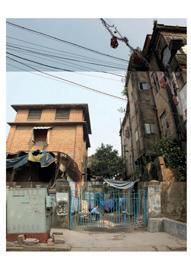

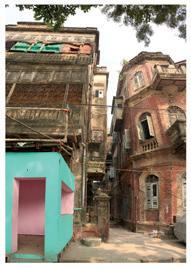
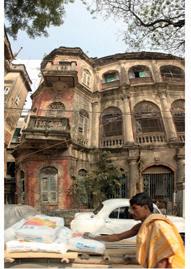
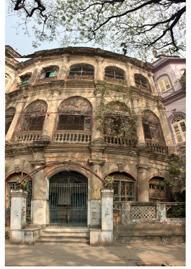



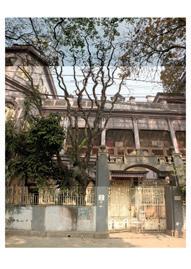

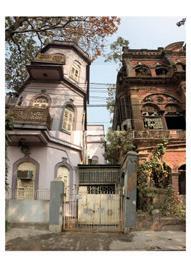


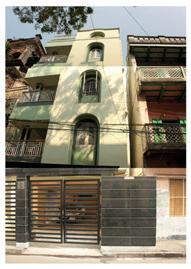

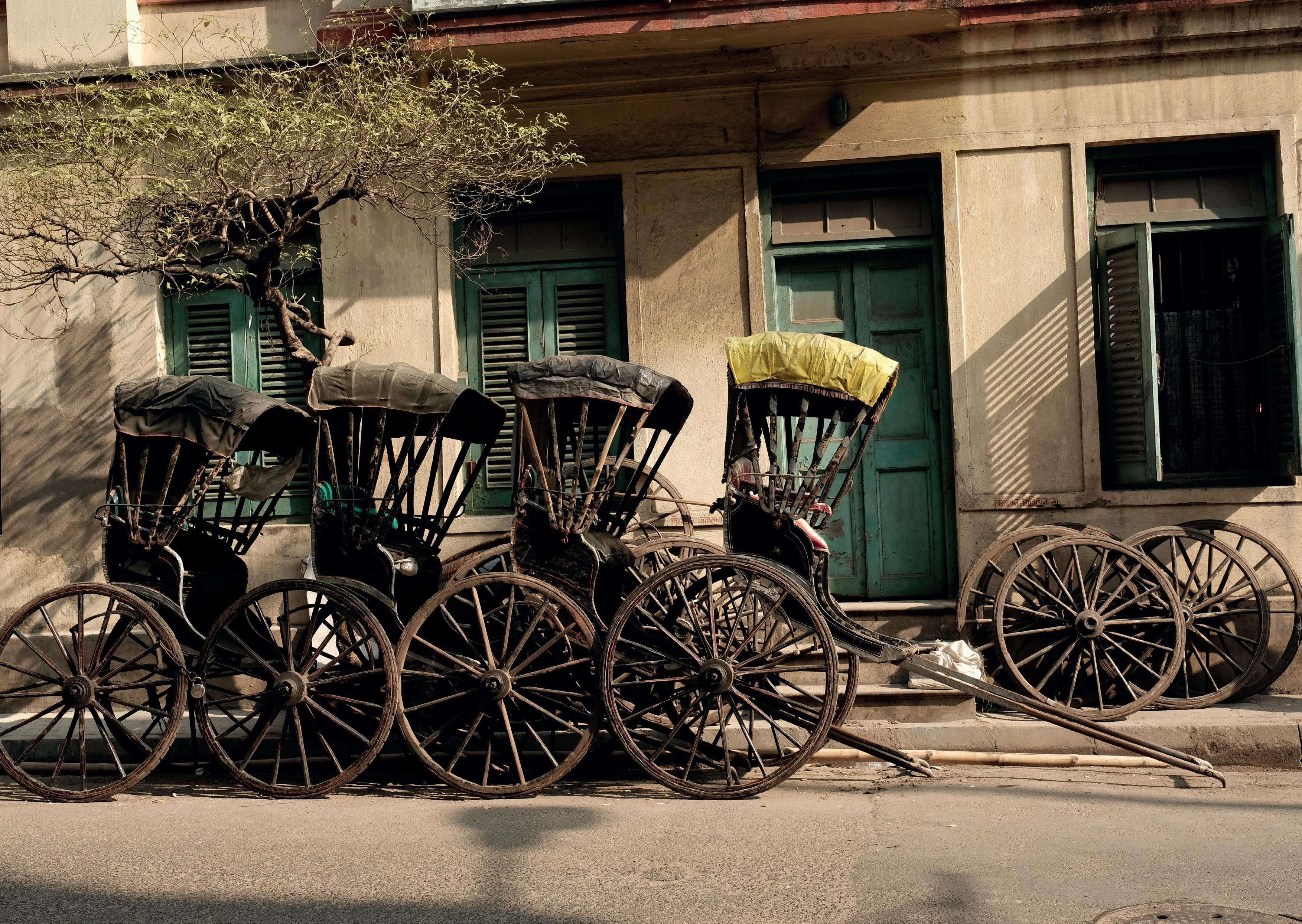

KUMARTULI
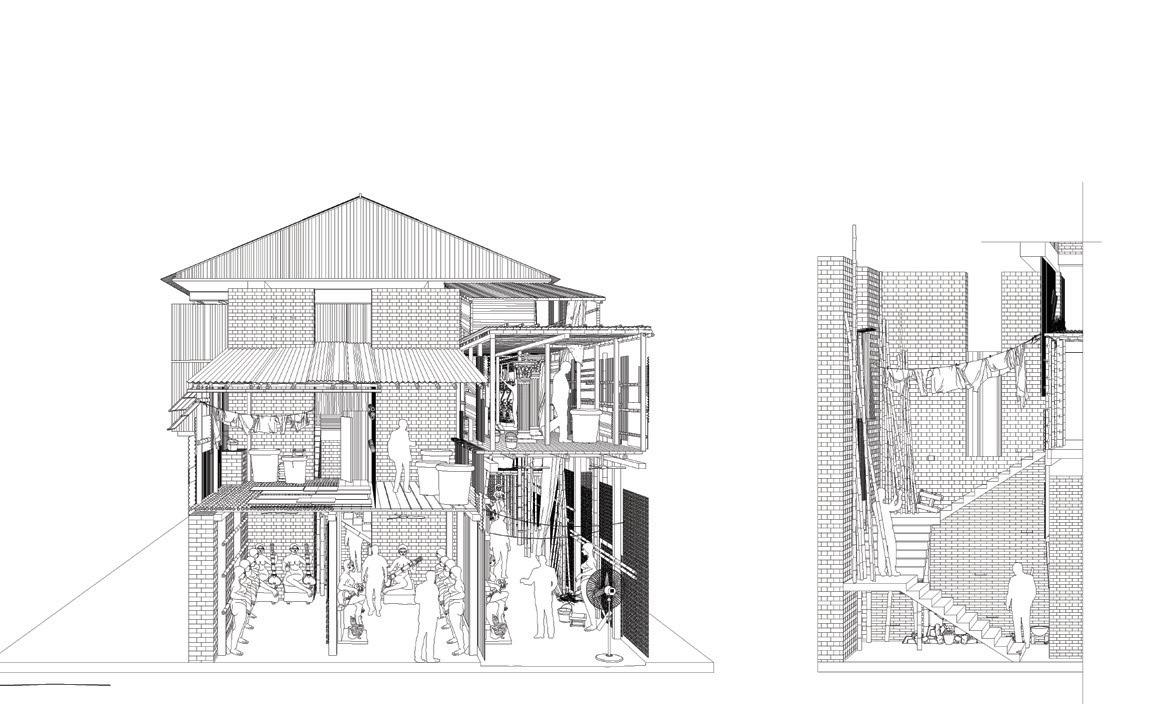


1 | Exploded Axonometric of Workshops in Kumartuli
2 | Perspectival Section through Workshops in Kumartuli
3 | Bonomali Sarkar Street Elevation
4 | Long Sections through Workshops in Kumartuli
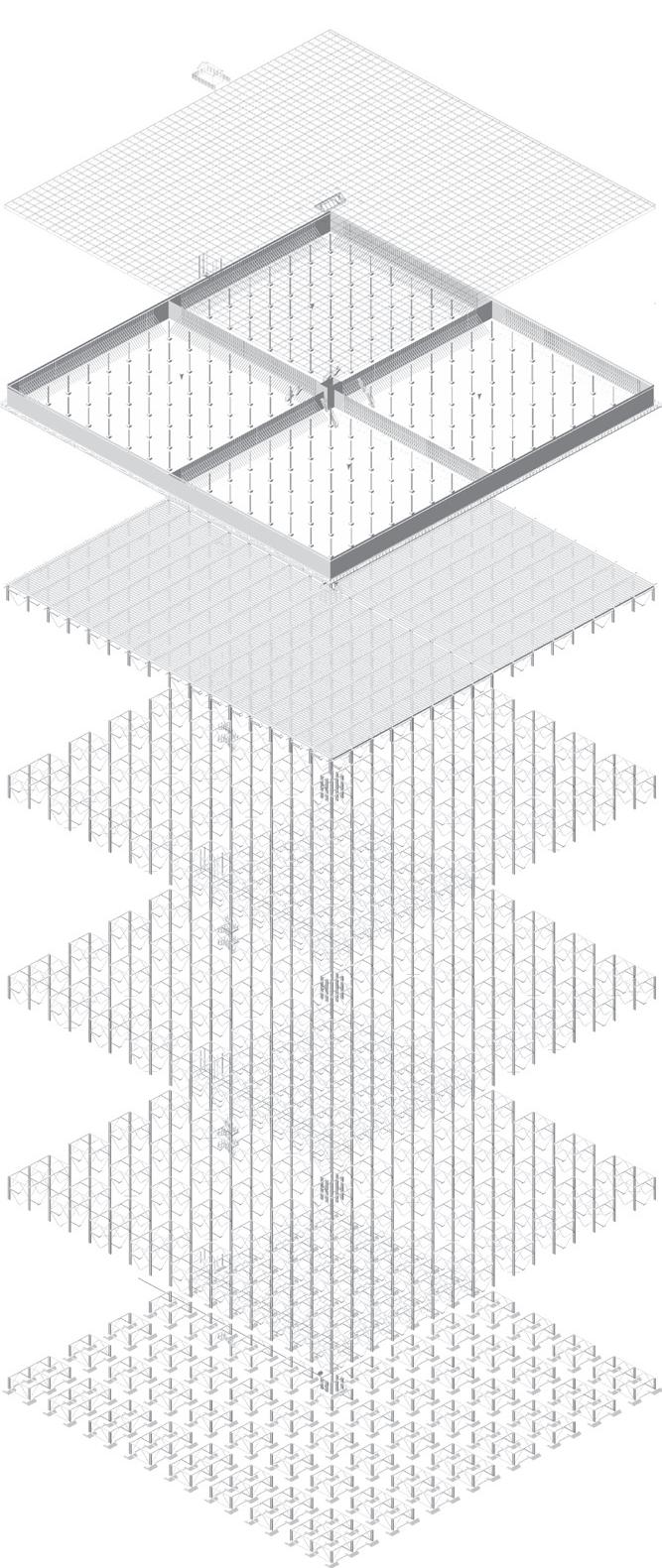

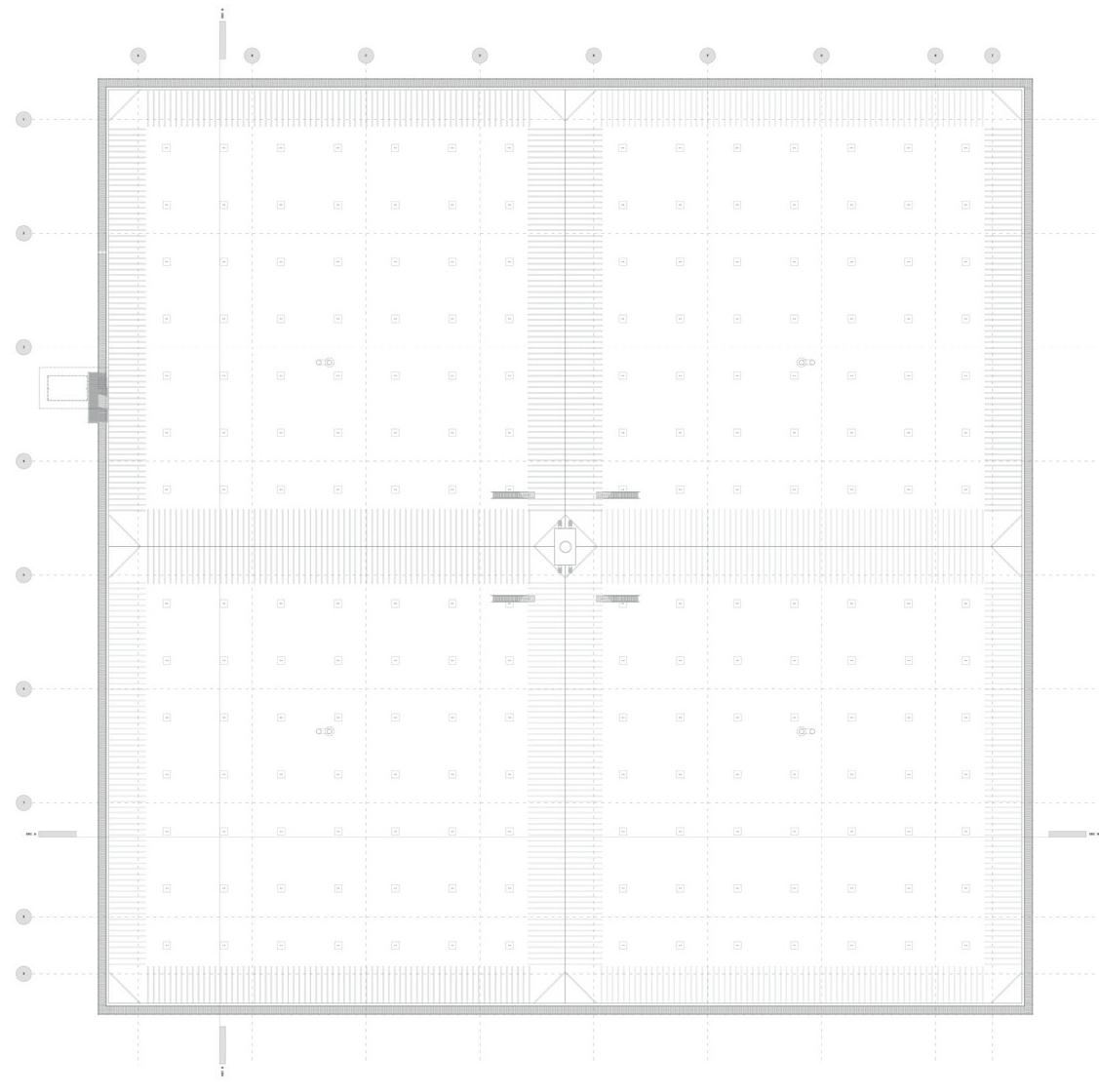

Tutors | Dorian Wiszniewski
Kevin Adams
Chris French
Maria Mitsoula
Neil Cunning
Visitors | Gijs Wallis de Vries
Yael Hameiri
Catherine Ingraham
Michael Webb
Luis Callejas
Nandini Sampat
James Craig
Anuradha Mathur, Dilip da Cunha, Amit Chaudhuri, Sukanya Mitra (Calcutta, January 2018)
David Narro, Andrew Leiper, Joanna John
Charles Bruce, Paul Pattinson, Roger Connah
Christopher Pierce
Stan Allen
Charlie Sutherland
Andy Bow
Technicians | Malcolm Cruickshank
Catriona Gilbert
Giulia Gentili
Rachel Collie
Julia Barbour
Michael Kay Terence
Special thanks | Ella Chmielewska
Catalogue designed and edited by | Kate Le Masurier, Eireann Iannetta-Mackay
Sub-edited by | Daana Bolot, Sabrina Syed, Andrew Chavet
The format of the catalogue has been developed and extended from the catalogue series for the ESALA MArch studios 2017-18, designed by Emma Bennett and Rachel Braude
Printed by | J Thomson Colour Printers Ltd., Glasgow
Cover image | Findlay McFarlane
Inside front cover | Outside the Marble Palace Entrance, Jorasanko, January 2018, Kate Le Masurier
P 2 | Plan of Calcutta 1 : 75 000, May 2019, Andrew Chavet
P 3 - 10 | Much Adda About Everything
Fig 1 | Bowali Mandal Road Calcutta, January 2018, Dorian Wiszniewski
Fig 2 | Calcutta Studio Rawk, Nov 2017, Kevin Adams
Fig 3 | Abhay Mitra Street elevation, Febuary 2018, Kate Le Masurier and Andrew Chavet
P 11 | House on Abhay Mitra Street, Kumartuli, January 2018, Kate Le Masurier
P 15 I In Addaon Rwaks, Goa Bagan, January 2018, Kate Le Masurier
P 25 | Selling Marigolds at Mullick Ghat Flower Market, B.B.D. Bagh, January 2018, Kate Le Masurier
P 75 | Idols on Kashi Mitra Gash Street, Kumartuli, January 2018, Daana Bolot
P 85 I Painting Calcutta’s Ocean of Wetness, Minto House Entrance, April 2019, Sabrina Syed
P 93 I On the Doorstep on Circular Canal, Seth Bagan, January 2018, Daana Bolot
P 101 I New Market, Sen Gupta Sarani, January 2018, Gbeke Akinkugbe
P 105 I Waiting in Howrah Railway Station, Howrah-1, January 2018, Desmond Chang
P 113 I Bethune Row, Azad Hind Bag, January 2018, Daana Bolot
P 119 | Calcutta MArch Exhibition 2019, 1:100, Matthew Gallery, Minto House, May 2019, Andrew Chavet
Inside back cover | House on Sardar Shankar Road, Kalighat, January 2018, Kate Le Masurier
Chaudhuri, Amit, Calcutta:TwoYearsInTheCity (London: Union Books, 2013).
da Cunha, Dilip, The Jungle’s Call, HarvardDesignMagazine, No.45, 2018.
Fraser, Bashabi, AMeetingofTwoMinds:GeddesTagoreLetters (Edinburgh: Word Power Bookshop, 2005). Geddes, Patrick, BarraBazarImprovement:AReporttoTheCorporationofCalcutta (Calcutta: The Corporation Press, 1919).
Mathur, Anurandha & Dilip da Cunha, ‘A Clash of first Natures’, ArgufyingCalcutta:Parasituation[Kolkata] (Edinburgh: Wedge Publications, 2019).
Rancière, Jacques, Dissensus On Politics and Aesthetics (Bloomsbury, 2015).
Sen, Amartya, TheArgumentativeIndian,WritingsonIndianCulture,HistoryandIdentity (London: Penguin Books, 2006).
Wiszniewski, Dorian, ArgufyingCalcutta:Parasituation[Kolkata] (Edinburgh: Wedge Publications, 2019).
imDb.com. 2019. Adda: Calcutta, Kolkata. [ONLINE] Available at: https://www.imdb.com/title/tt2381081/?, Accessed 12/03/2019.
